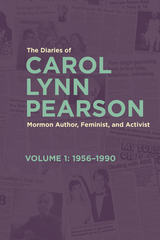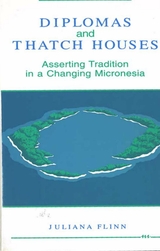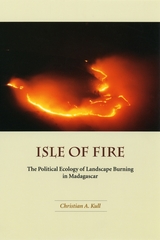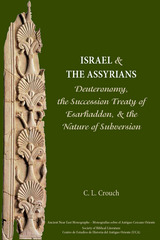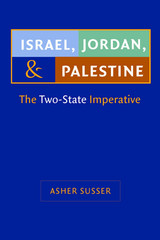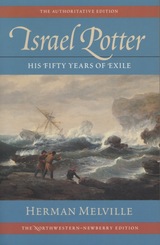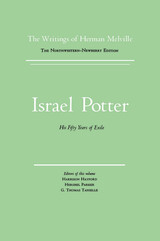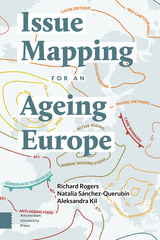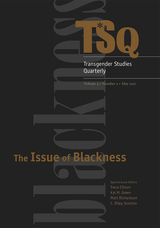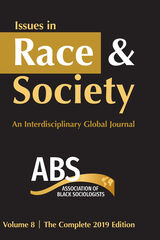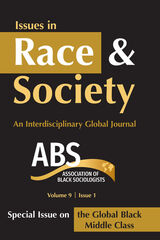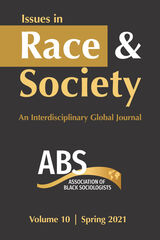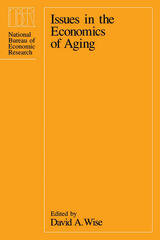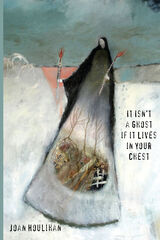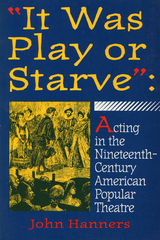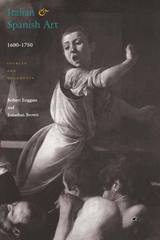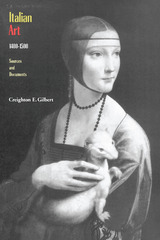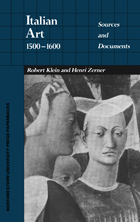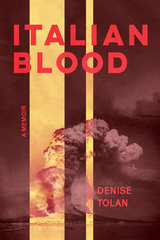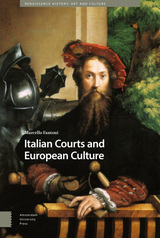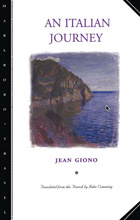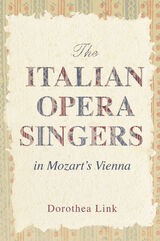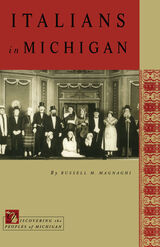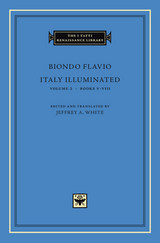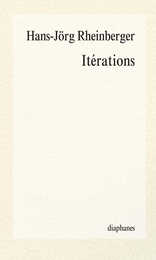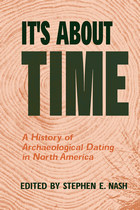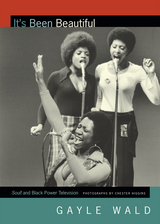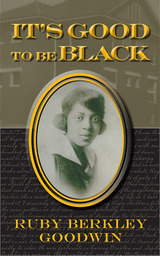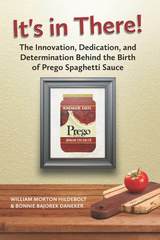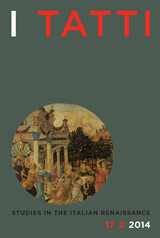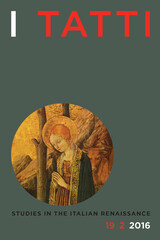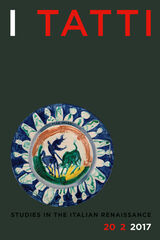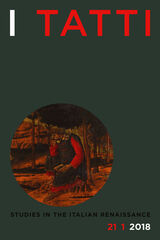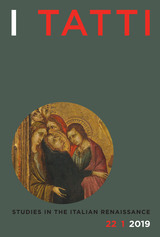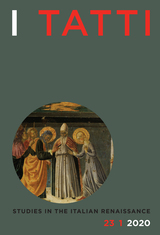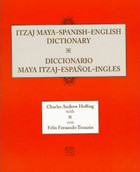Isle of Fire: The Political Ecology of Landscape Burning in Madagascar
Christian A. Kull
University of Chicago Press, 2004 Long considered both best friend and worst enemy to humankind, fire is at once creative and destructive. On the endangered tropical island of Madagascar, these two faces of fire have fueled a century-long conflict between rural farmers and island leaders. Based on detailed fieldwork in Malagasy villages and a thorough archival investigation, Isle of Fire offers a detailed analysis of why Madagascar has always been aflame, why it always will be aflame, and ultimately, as Christian Kull argues, why it should remain aflame.
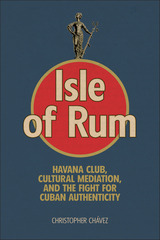 Isle of Rum: Havana Club, Cultural Mediation, and the Fight for Cuban Authenticity
Christopher Chávez
Rutgers University Press, 2024 Focusing on Havana Club rum as a case study, Isle of Rum examines the ways in which Western cultural producers, working in collaboration with the Cuban state, have assumed responsibility for representing Cuba to the outside world. Christopher Chávez focuses specifically on the role of advertising practitioners, musicians, filmmakers, and visual artists, who stand to benefit economically by selling an image of Cuba to consumers who desperately crave authentic experiences that exist outside of the purview of the marketplace.
Rather than laying claim to authentic Cuban culture, Chávez explores which aspects of Cuban culture are deemed most compelling and, therefore, most profitable by corporate marketers. As a joint venture between the Cuban state and Pernod Ricard, a global spirits marketer based in Paris, Havana Club embodies the larger process of economic reform, which was meant to reintegrate Cuba into global markets during Cuba’s Special Period in a Time of Peace.
 The IS-LM Model: Its Rise, Fall, and Strange Persistence, Volume 36
Michel De Vroey and Kevin D. Hoover, eds.
Duke University Press For some twenty-five years after the end of the Second World War, the IS-LM model dominated macroeconomics. Inspired by the work of John Maynard Keynes, this model demonstrates the relationship among savings, income, investments, and interest rates, showing the point at which the interaction of these elements produces “equilibrium” in an economy. With the advent of the new classical macroeconomics in the early 1970s, the dominance of the IS-LM model was effectively challenged. While no longer central to the graduate training of most macroeconomists or to cutting-edge macroeconomic research, the IS-LM model continues to be a mainstay of undergraduate textbooks, to find wide use in applied macroeconomics, and to lie at the conceptual core of most government and commercial macroeconometric models. This volume, the annual supplement to History of Political Economy, explores the rise, the fall, and the persistence of the IS-LM model. In addition to presenting papers from the History of Political Economy conference held at Duke University in April 2003, the volume includes the text of an address delivered at the conference by Nobel laureate Robert E. Lucas Jr., one of the central players in the intellectual movement that dethroned the IS-LM model. Contributors. Roger E. Backhouse, Mauro Boianovsky, Michael Bordo, David Colander, William Darity Jr., Michel De Vroey, Robert W. Dimand, Kevin D. Hoover, David Laidler, Robert E. Lucas Jr., Edward Nelson, Goulven Rubin, Anna Schwartz, Scott Sumner, Warren Young
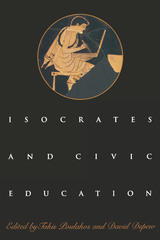 Isocrates and Civic Education
Edited by Takis Poulakos and David Depew
University of Texas Press, 2004 Civic virtue and the type of education that produces publicly minded citizens became a topic of debate in American political discourse of the 1980s, as it once was among the intelligentsia of Classical Athens. Conservatives such as former National Endowment for the Humanities chairman William Bennett and his successor Lynn Cheney held up the Greek philosopher Aristotle as the model of a public-spirited, virtue-centered civic educator. But according to the contributors in this volume, a truer model, both in his own time and for ours, is Isocrates, one of the preeminent intellectual figures in Greece during the fourth century B.C. In this volume, ten leading scholars of Classics, rhetoric, and philosophy offer a pathfinding interdisciplinary study of Isocrates as a civic educator. Their essays are grouped into sections that investigate Isocrates' program in civic education in general (J. Ober, T. Poulakos) and in comparison to the Sophists (J. Poulakos, E. Haskins), Plato (D. Konstan, K. Morgan), Aristotle (D. Depew, E. Garver), and contemporary views about civic education (R. Hariman, M. Leff). The contributors show that Isocrates' rhetorical innovations carved out a deliberative process that attached moral choices to political questions and addressed ethical concerns as they could be realized concretely. His notions of civic education thus created perspectives that, unlike the elitism of Aristotle, could be used to strengthen democracy.
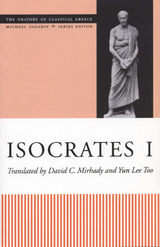 Isocrates I
Translated by David C. Mirhady and Yun Lee Too
University of Texas Press, 2000 This is the fourth volume in the Oratory of Classical Greece series. Planned for publication over several years, the series will present all of the surviving speeches from the late fifth and fourth centuries B.C. in new translations prepared by classical scholars who are at the forefront of the discipline. These translations are especially designed for the needs and interests of today's undergraduates, Greekless scholars in other disciplines, and the general public. Classical oratory is an invaluable resource for the study of ancient Greek life and culture. The speeches offer evidence on Greek moral views, social and economic conditions, political and social ideology, and other aspects of Athenian culture that have been largely ignored: women and family life, slavery, and religion, to name just a few. This volume contains works from the early, middle, and late career of the Athenian rhetorician Isocrates (436-338). Among the translated works are his legal speeches, pedagogical essays, and his lengthy autobiographical defense, Antidosis. In them, he seeks to distinguish himself and his work, which he characterizes as "philosophy," from that of the sophists and other intellectuals such as Plato. Isocrates' identity as a teacher was an important mode of political activity, through which he sought to instruct his students, foreign rulers, and his fellow Athenians. He was a controversial figure who championed a role for the written word in fourth-century politics and thought.
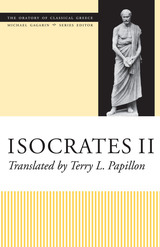 Isocrates II
Translated by Terry L. Papillon
University of Texas Press, 2004 This is the seventh volume in the Oratory of Classical Greece. This series presents all of the surviving speeches from the late fifth and fourth centuries BC in new translations prepared by classical scholars who are at the forefront of the discipline. These translations are especially designed for the needs and interests of today's undergraduates, Greekless scholars in other disciplines, and the general public. Classical oratory is an invaluable resource for the study of ancient Greek life and culture. The speeches offer evidence on Greek moral views, social and economic conditions, political and social ideology, law and legal procedure, and other aspects of Athenian culture that have been largely ignored: women and family life, slavery, and religion, to name just a few. The Athenian rhetorician Isocrates (436-338) was one of the leading intellectual figures of the fourth century. This volume contains his orations 4, 5, 6, 8, 12, and 14, as well as all of his letters. These are Isocrates' political works. Three of the discourses—Panathenaicus, On the Peace, and the most famous, Panegyricus—focus on Athens, Isocrates' home. Archidamus is written in the voice of the Spartan prince to his assembly, and Plataicus is in the voice of a citizen of Plataea asking Athens for aid, while in To Philip, Isocrates himself calls on Philip of Macedon to lead a unified Greece against Persia.
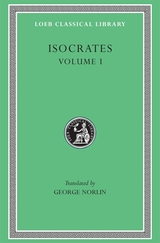 Isocrates, Volume I: To Demonicus. To Nicocles. Nicocles or the Cyprians. Panegyricus. To Philip. Archidamus
Isocrates
Harvard University Press The sophisticated schoolmaster.
The importance of Isocrates for the study of Greek civilization of the fourth century BC is indisputable. From 403 to 393 he wrote speeches for Athenian law courts, and then became a teacher of composition for would-be orators. After setting up a school of rhetoric in Chios he returned to Athens and established there a free school of “philosophia” involving a practical education of the whole mind, character, judgment, and mastery of language. This school had famous pupils from all over the Greek world, such as the historians Ephorus and Theopompus and orators Isaeus, Lycurgus, and Hypereides. Isocrates also wrote in gifted style essays on political questions, his main idea being a united Greece to conquer the Persian empire. Thus in his fine Panegyricus (written for the 100th Olympiad gathering in 380) he urged that the leadership should be granted to Athens, possibly in conjunction with Sparta. In the end he looked to Philip of Macedon, but died just as Philip’s supremacy in Greece began.
Twenty-one discourses by Isocrates survive; these include political essays, treatises on education and on ethics, and speeches for legal cases. Nine letters are also extant; they are concerned more with public than with private matters. The Loeb Classical Library edition of Isocrates is in three volumes. Volume I contains six discourses: To Demonicus, To Nicocles, Nicocles or The Cyprians, Panegyricus, To Philip, and Archidamus. Five are in Volume II: Areopagiticus, On the Peace, Panathenaicus, Against the Sophists, Antidosis. Volume III contains Evagoras, Helen, Busiris, Plataicus, Concerning the Team of Horses, Trapeziticus, Against Callimachus, Aegineticus, Against Lochites, and Against Euthynus, as well as the nine extant letters and a comprehensive index.
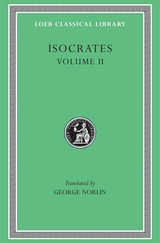 Isocrates, Volume II: On the Peace. Areopagiticus. Against the Sophists. Antidosis. Panathenaicus
Isocrates
Harvard University Press The sophisticated schoolmaster.
The importance of Isocrates for the study of Greek civilization of the fourth century BC is indisputable. From 403 to 393 he wrote speeches for Athenian law courts, and then became a teacher of composition for would-be orators. After setting up a school of rhetoric in Chios he returned to Athens and established there a free school of “philosophia” involving a practical education of the whole mind, character, judgment, and mastery of language. This school had famous pupils from all over the Greek world, such as the historians Ephorus and Theopompus and orators Isaeus, Lycurgus, and Hypereides. Isocrates also wrote in gifted style essays on political questions, his main idea being a united Greece to conquer the Persian empire. Thus in his fine Panegyricus (written for the 100th Olympiad gathering in 380) he urged that the leadership should be granted to Athens, possibly in conjunction with Sparta. In the end he looked to Philip of Macedon, but died just as Philip’s supremacy in Greece began.
Twenty-one discourses by Isocrates survive; these include political essays, treatises on education and on ethics, and speeches for legal cases. Nine letters are also extant; they are concerned more with public than with private matters. The Loeb Classical Library edition of Isocrates is in three volumes. Volume I contains six discourses: To Demonicus, To Nicocles, Nicocles or The Cyprians, Panegyricus, To Philip, and Archidamus. Five are in Volume II: Areopagiticus, On the Peace, Panathenaicus, Against the Sophists, Antidosis. Volume III contains Evagoras, Helen, Busiris, Plataicus, Concerning the Team of Horses, Trapeziticus, Against Callimachus, Aegineticus, Against Lochites, and Against Euthynus, as well as the nine extant letters and a comprehensive index.
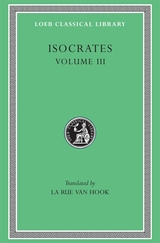 Isocrates, Volume III: Evagoras. Helen. Busiris. Plataicus. Concerning the Team of Horses. Trapeziticus. Against Callimachus. Aegineticus. Against Lochites. Against Euthynus. Letters
Isocrates
Harvard University Press The sophisticated schoolmaster.
The importance of Isocrates for the study of Greek civilization of the fourth century BC is indisputable. From 403 to 393 he wrote speeches for Athenian law courts, and then became a teacher of composition for would-be orators. After setting up a school of rhetoric in Chios he returned to Athens and established there a free school of “philosophia” involving a practical education of the whole mind, character, judgment, and mastery of language. This school had famous pupils from all over the Greek world, such as the historians Ephorus and Theopompus and orators Isaeus, Lycurgus, and Hypereides. Isocrates also wrote in gifted style essays on political questions, his main idea being a united Greece to conquer the Persian empire. Thus in his fine Panegyricus (written for the 100th Olympiad gathering in 380) he urged that the leadership should be granted to Athens, possibly in conjunction with Sparta. In the end he looked to Philip of Macedon, but died just as Philip’s supremacy in Greece began.
Twenty-one discourses by Isocrates survive; these include political essays, treatises on education and on ethics, and speeches for legal cases. Nine letters are also extant; they are concerned more with public than with private matters. The Loeb Classical Library edition of Isocrates is in three volumes. Volume I contains six discourses: To Demonicus, To Nicocles, Nicocles or The Cyprians, Panegyricus, To Philip, and Archidamus. Five are in Volume II: Areopagiticus, On the Peace, Panathenaicus, Against the Sophists, Antidosis. Volume III contains Evagoras, Helen, Busiris, Plataicus, Concerning the Team of Horses, Trapeziticus, Against Callimachus, Aegineticus, Against Lochites, and Against Euthynus, as well as the nine extant letters and a comprehensive index.
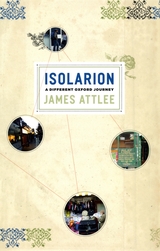 Isolarion: A Different Oxford Journey
James Attlee
University of Chicago Press, 2007 Through the centuries, people from all walks of life have heard the siren call of a pilgrimage, the lure to journey away from the familiar in search of understanding. But is a pilgrimage even possible these days for city-dwellers enmeshed in the pressures of work and family life? Or is there a way to be a pilgrim without leaving one’s life behind? James Attlee answers these questions with Isolarion, a thoughtful, streetwise, and personal account of his pilgrimage to a place he thought he already knew—the Cowley Road in Oxford, right outside his door.
Isolarion takes its title from a type of fifteenth-century map that isolates an area in order to present it in detail, and that’s what Attlee, sharp-eyed and armed with tape recorder and notebook, provides for Cowley Road. The former site of a leper hospital, a workhouse, and a medieval well said to have miraculous healing powers, Cowley Road has little to do with the dreaming spires of the tourist’s or student’s Oxford. What Attlee presents instead is a thoroughly modern, impressively cosmopolitan, and utterly organic collection of shops, restaurants, pubs, and religious establishments teeming with life and reflecting the multicultural makeup of the surrounding neighborhood.
From a sojourn in a sensory-deprivation tank to a furtive visit to an unmarked pornography emporium, Attlee investigates every aspect of the Cowley Road’s appealingly eclectic culture, where halal shops jostle with craft jewelers and reggae clubs pulsate alongside quiet churchyards. But the very diversity that is, for Attlee, the essence of Cowley Road’s appeal is under attack from well-meaning city planners and predatory developers. His pilgrimage is thus invested with melancholy: will the messy glories of the Cowley Road be lost to creeping homogenization?
Drawing inspiration from sources ranging from Robert Burton’s The Anatomy of Melancholy to contemporary art, Attlee is a charming and companionable guide who revels in the extraordinary embedded in the everyday. Isolarion is at once a road movie, a quixotic stand against uniformity, and a rousing hymn in praise of the complex, invigorating nature of the twenty-first-century city.
 Isolated Islands in Medieval Nature, Culture and Mind
Gerhard Jaritz
Central European University Press, 2011 The volume contains selected papers from an international workshop in 2005, at the Hungarian Academy in Rome. They aim at investigating the registers of fifteenth-century supplications to the Apostolic Penitentiary of the Holy See and to analyze the multiplicity of issues in which a context of the local needs of Western Christians and the central power of the Pope had been occurring. The contributions make clear that local and individual factors and practice of Christian faith and religion must not be seen as separated from the global power of the Roman curia. The latter’s influence could become directly important for any individual in any local space, also … et usque ad ultimum terrae (Acts 1:8), in the utmost peripheries of the Christian world. The assistance by the Apostolic Penitentiary was indispensable in a large variety of cases. The occupation with such cases happened in the local and regional space as well as in the globalized centre of the Holy See.
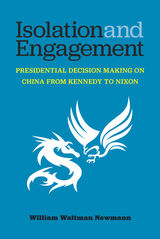 Isolation and Engagement: Presidential Decision Making on China from Kennedy to Nixon
William Waltman Newmann
University of Michigan Press, 2022 Presidents and their advisors consistently seek to improve the management of their foreign policy decision processes. This book analyzes the successes and failures of administrations from Kennedy to Nixon as they sought to strike a balance between the personal style of the president and the need for a strong interagency structure that could systematically evaluate policy options. The narrative focuses on US decision making on China and Taiwan during the crucial era when the US was considering moving from a policy of isolating China to a policy of engagement, culminating in Nixon’s historic 1972 trip to China. William Waltman Newmann has created an Evolution-Balancing model, tested with case studies focusing on China policy by Kennedy, Johnson, Nixon, and Ford, showing how the relationships between a president and his advisors change based on the weaknesses or pathologies of the president’s management style. The author’s research is based on declassified archival material from the Eisenhower, Kennedy, Johnson, Nixon, and Ford presidential libraries.
 Isolato
Larissa Szporluk
University of Iowa Press, 2000 The short lyric poems in Larissa Szporluk's new collection, Isolato, search for meaning and beauty—for poetry—in an unpredictable and incomprehensible world. Their voices break from the contemporary preoccupation with autobiography, held together by language rather than a sustained narrative or plot. Yet the narrative fragments clearly evoke certain themes and moods: interaction of and struggle between the human and natural world; violence, particularly against women and children; alienation and betrayal; the mysteries of the universe, God, and death; and, of course, poetry itself. Variously called a religious, a metaphysical, or a visionary poet, Szporluk has been compared to Emily Dickinson and George Herbert as well as to twentieth-century poets like Sylvia Plath, Mark Strand, and Louise Glück. Her work is concise, experimental, and challenging. Language and syntax are often elusive, the logic that of dreams or music, the imagery mysterious. The poems, once read, are not easily dismissed. Like the poet's “Deer Crossing the Sea,”readers find “the promise of nectar / haunts them forever, the shore pecked out / of their eyes, and there, in its stead, / something greater to catch, / a scent that would paralyze God.”
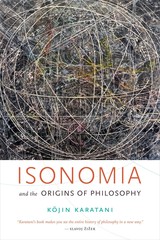 Isonomia and the Origins of Philosophy
Kojin Karatani
Duke University Press, 2017 In Isonomia and the Origins of Philosophy—published originally in Japanese and now available in four languages—Kōjin Karatani questions the idealization of ancient Athens as the source of philosophy and democracy by placing the origins instead in Ionia, a set of Greek colonies located in present-day Turkey. Contrasting Athenian democracy with Ionian isonomia—a system based on non-rule and a lack of social divisions whereby equality is realized through the freedom to immigrate—Karatani shows how early Greek thinkers from Heraclitus to Pythagoras were inseparably linked to the isonomia of their Ionian origins, not democracy. He finds in isonomia a model for how an egalitarian society not driven by class antagonism might be put into practice, and resituates Socrates's work and that of his intellectual heirs as the last philosophical attempts to practice isonomia's utopic potentials. Karatani subtly interrogates the democratic commitments of Western philosophy from within and argues that the key to transcending their contradictions lies not in Athenian democracy, with its echoes of imperialism, slavery, and exclusion, but in the openness of isonomia.
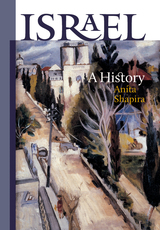 Israel: A History
Anita Shapira
Brandeis University Press, 2014 Written by one of Israel’s most notable scholars, this volume provides a breathtaking history of Israel from the origins of the Zionist movement in the late nineteenth century to the present day. Organized chronologically, the volume explores the emergence of Zionism in Europe against the backdrop of relations among Jews, Arabs, and Turks, and the earliest pioneer settlements in Palestine under Ottoman rule. Weaving together political, social, and cultural developments in Palestine under the British mandate, Shapira creates a tapestry through which to understand the challenges of Israeli nation building, including mass immigration, shifting cultural norms, the politics of war and world diplomacy, and the creation of democratic institutions and a civil society. References to contemporary diaries, memoirs, and literature bring a human dimension to this narrative history of Israel from its declaration of independence in 1948 through successive decades of waging war, negotiating peace, and building a modern state with a vibrant society and culture. Based on archival sources and the most up-to-date scholarly research, this authoritative history is a must-read for anyone with a passionate interest in Israel. Israel: A History will be the gold standard in the field for years to come.
 Israel and Palestine: Competing Histories
Greg Philo and Mike Berry
Pluto Press, 2006 Following on from their acclaimed book Bad News from Israel, Greg Philo and Mike Berry present a concise guide to the Israel-Palestine conflict. This uniquely accessible book will appeal to anyone looking for an approachable introduction. Uniquely, the authors show how there are many different, competing histories. They offer an overview of the wide range of contending viewpoints, and indicate those which are based on the most considered historical research.
The book covers key events in chronological order, in each case examining the varied historical accounts and presenting the beliefs of key thinkers across the ideological spectrum, from Edward Said to Binyamin Netanyahu. Starting the with emergence of the Zionist movement in the nineteenth century, and the figures who shaped it, the authors go on to cover the founding of Israel and its subsequent history, up to and including the 'roadmap for peace', the construction of the wall, the death of Arafat and the withdrawal from Gaza.
 Israel and Settler Society
Lorenzo Veracini
Pluto Press, 2006 The struggle between Israel and the Palestinians is not unique -- whatever the news media may suggest. Lorenzo Veracini argues that the conflict is best understood in terms of colonialism. Like many other societies, Israel is a settler society. Looking in detail at the evolution of other colonial regimes -- apartheid South Africa, French Algeria and Australia -- Veracini presents a thoughtful interpretation of the dynamics of colonialism, offering a clear framework within which to understand the middle east crisis.
Veracini challenges two important myths: firstly, that the Israeli-Palestinian dispute is unique and defies comparative approaches; and secondly that the struggle is mainly based in nationality and religion and therefore different to typical colonial conflicts. On the contrary, Veracini shows how Israeli society is organised along apartheid lines -- and that apartheid was not unique to South Africa, but a common feature of colonisation. He examines wars of decolonization, and conflicts where whole native populations were all but eradicated -- as in Australia. Comparing and contrasting these with the more recent history of Israel and Palestine, he offers a critical perspective on colonialism as well as important new insights into patterns of imperialism today.
Israel and the American National Interest: A Critical Examination
Cheryl A. Rubenberg
University of Illinois Press, 1986 "Israel's special relationship with the united States has come under close public scrutiny in recent months following revelations about Israeli involvement in the Iran-Contra and Jonathan Pollard spy scandals. Cheryl Rubenberg's controversial new book traces the evolution of that relationship from the Truman through the Reagan administrations and challenges the widely held view that close ties between Tel Aviv and Washington have served U. S. interests well in the Middle East. Indeed, she makes a convincing case that, in the two decades since 1967, U.S. policymakers have tended to confuse what is best for Israel with what is best for the United States and to ignore what she regards as the most pressing problem in the Middle East, the quest for a Palestinian homeland." -- Douglas Little, International History Review
Israel and the Assyrians: Deuteronomy, the Succession Treaty of Esarhaddon, and the Nature of Subvers
C. L. Crouch
SBL Press, 2014 Was Deuteronomy created to be a subversive text based on Assyian treaties?
In this new book Crouch focuses on Deuteronomy’s subversive intent, asking what would be required in order for Deuteronomy to successfully subvert either a specific Assyrian source or Assyrian ideology more generally. The book reconsiders the nature of the relationship between Deuteronomy and Assyria, Deuteronomy’s relationship to ancient Near Eastern and biblical treaty and loyalty oath traditions, and the relevance of Deuteronomy’s treaty affinities to discussions of its date.
Features:
- A thorough investigation of the nature and requirements of subversion
- A focused examination of the context in which Deuteronomy would have functioned
- An appendix focused on redactional questions related to Deuteronoy 13 and 28
Israel and the Clash of Civilisations: Iraq, Iran and the Plan to Remake the Middle East
Jonathan Cook
Pluto Press, 2008 Journalist Jonathan Cook explores Israel’s key role in persuading the Bush administration to invade Iraq, as part of a plan to remake the Middle East, and their joint determination to isolate Iran and prevent it from acquiring nuclear weapons that might rival Israel’s own.
This concise and clearly argued book makes the case that Israel's desire to be the sole regional power in the Middle East neatly chimed with Bush’s objectives in the “war on terror”.
Examining a host of related issues, from the ethnic cleansing of Palestinians to the role of Big Oil and the demonisation of the Arab world, Cook argues that the current chaos in the Middle East is the objective of the Bush administration – a policy that is equally beneficial to Israel.
Israel as a Modern Architectural Experimental Lab, 1948-1978
Edited by Inbal Ben-Asher Gitler and Anat Geva
Intellect Books, 2019 This collection discusses the innovative and experimental architecture of Israel during its first three decades following the nation’s establishment in 1948. Written by leading researchers, the volume highlights new perspectives on the topic, discussing the inception, modernization, and habitation of historic and lesser-researched areas alike in its interrogation. Inbal Ben-Asher Gitler and Anat Geva show how Israeli nation building, in its cultural, political, and historical contexts, constituted an exceptional experiment in modern architecture. Examples include modern experiments in mass housing design; public architecture such as exhibition spaces, youth villages, and synagogues; a necessary consideration of climate in modern architectural experiments; and the exportation of Israeli modern architecture to other countries.
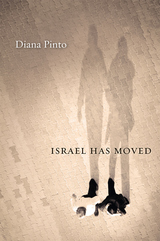 Israel Has Moved
Diana Pinto
Harvard University Press, 2013 Israel has changed. The country was born in Europe’s shadow, haunted by the Holocaust and inspired by the Enlightenment. But for Israelis today, Europe is hardly relevant, and the country’s ties to the broader West, even to America, are fraying. Where is Israel heading? How do citizens of an increasingly diverse nation see themselves globally and historically?
In this revealing portrait of the new Israel, Diana Pinto presents a country simultaneously moving forward and backward, looking outward and turning in on itself. In business, Israel is forging new links with the giants of Asia, and its booming science and technology sectors are helping define the future for the entire world. But in politics and religion, Israelis are increasingly self-absorbed, building literal and metaphorical walls against hostile neighbors and turning to ancient religious precepts for guidance here and now.
Pinto captures the new moods and mindsets, the anxieties and hopes of Israelis today in sharply drawn sketches of symbolically charged settings. She takes us on the roads to Jerusalem, to border control at Ben Gurion Airport, to a major Israeli conference in Jerusalem, to a hill overlooking the Dome of the Rock and Temple Mount, to the heart of Israel’s high-tech economy, and to sparkling new malls and restaurants where people of different identities share nothing more than a desire to ignore one another.
Vivid and passionate but underpinned by deep analysis, this is a profound and sometimes unsettling account of a country that is no longer where we might think.
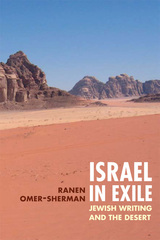 Israel in Exile: Jewish Writing and the Desert
Ranen Omer-Sherman
University of Illinois Press, 2006 Israel in Exile is a bold exploration of how the ancient desert of Exodus and Numbers, as archetypal site of human liberation, forms a template for modern political identities, radical skepticism, and questioning of official narratives of the nation that appear in the works of contemporary Israeli authors including David Grossman, Shulamith Hareven, and Amos Oz, as well as diasporic writers such as Edmund Jabès and Simone Zelitch.
In contrast to other ethnic and national representations, Jewish writers since antiquity have not constructed a neat antithesis between the desert and the city or nation; rather, the desert becomes a symbol against which the values of the city or nation can be tested, measured, and sometimes found wanting. This book examines how the ethical tension between the clashing Mosaic and Davidic paradigms of the desert still reverberate in secular Jewish literature and produce fascinating literary rewards. Omer-Sherman ultimately argues that the ancient encounter with the desert acquires a renewed urgency in response to the crisis brought about by national identities and territorial conflicts.
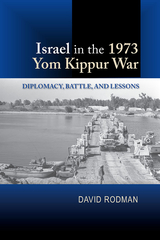 Israel in the 1973 Yom Kippur War: Diplomacy, Battle and Lessons
David Rodman
Sussex Academic Press, 2022 The State of Israel faced one of its most difficult challenges during the 1973 Yom Kippur War. Though the Israel Defense Forces (IDF) eventually emerged as the clear victor in the war, it suffered serious reverses at the outset of hostilities, as well as substantial losses in men and equipment. This book revisits the Yom Kippur War by exploring a number of issues that would benefit from a fresh evaluation. Among the issues examined are: the American-Israeli and Jordanian-Israeli relationships during the war; the roles of Israeli nuclear weapons and airpower; the IDF's practice of combined arms warfare; the reasons why the IDF turned the tide of the war more quickly on the Golan front than on the Sinai front; the impact of American arms transfers; and the lessons derived from the war by the United States Army and the IDF. Relying heavily on government documents and other primary sources of information, this book helps to fill important descriptive and analytical gaps in the academic literature about the Yom Kippur War. No other book compares to it in respect of content and interpretation. It is, in short, essential reading for all scholars interested in the diplomatic and military dimensions of the war. [Subject: Military History, Israel Studies, History, Middle East Studies]
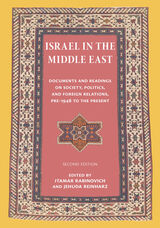 Israel in the Middle East: Documents and Readings on Society, Politics, and Foreign Relations, Pre-1948 to the Present
Edited by Itamar Rabinovich and Jehuda Reinharz
Brandeis University Press, 2007 This timely anthology, completely revised and updated from the original edition in 1984, provides convenient access to the most significant documents of the Zionist movement since 1882 and of Israel’s domestic and foreign policy issues between 1948 and 2006. Comprised largely of primary sources from Israeli, Arab, and American records, documents encompass not only political and diplomatic history but economic, cultural, legal and social aspects of the region as well. The second edition also addresses areas not covered by the 1984 volume: a new chapter on the pre-state period, additional documents that reflect the Palestinian perspective, and the voices of women. Divided into seven chronological sections, documents are introduced by an overview of the entire era. They are annotated and preceded by explanatory headnotes.
Israel, Jordan, and Palestine: The Two-State Imperative
Asher Susser
Brandeis University Press, 2011 Since 1921, the Zionist movement, the Hashemites, and Palestinian nationalists have been vying for regional control. In this book, Asher Susser analyzes the evolution of the one- and two-state options and explores why a two-state solution has failed to materialize. He provides an in-depth analysis of Jordan’s positions and presents an updated discussion of the two-state imperative through the initiatives of Israel and the Palestinian Authority. Susser argues that Israelis, Palestinians, and Jordanians have cohesive collective identities that violently collide with each other. Because of these entrenched differences, a single-state solution cannot be achieved.
Israel Potter: His Fifty Years of Exile, Volume Eight
Herman Melville
Northwestern University Press, 1997 Unique among Melville's works, Israel Potter was the author's only historical novel, presuming to offer the life history of Revolutionary War figure Israel Potter--based on Potter's own obscure narrative Life and Remarkable Adventures of Israel R. Potter--and featuring characters such as Benjamin Franklin and Ethan Allen. In offering the manuscript to his publisher, Melville assured him, "I engage that the story shall contain nothing of any sort to shock the fastidious. There will be very little reflective writing in it; nothing weighty. It is adventure." This came as a relief, for his previous novel, Pierre, had shocked readers and brought down universal castigation.
This edition is an Approved Text of the Center for Editions of American Authors (Modern Language Association of America).
Israel Potter: His Fifty Years of Exile, Volume Eight, Scholarly Edition
Herman Melville
Northwestern University Press, 1982 Unique among Melville's works, Israel Potter was the author's only historical novel, presuming to offer the life history of Revolutionary War figure Israel Potter--based on Potter's own obscure narrative Life and Remarkable Adventures of Israel R. Potter--and featuring characters such as Benjamin Franklin and Ethan Allen. In offering the manuscript to his publisher, Melville assured him, "I engage that the story shall contain nothing of any sort to shock the fastidious. There will be very little reflective writing in it; nothing weighty. It is adventure." This came as a relief, for his previous novel, Pierre, had shocked readers and brought down universal castigation.
This edition is an Approved Text of the Center for Editions of American Authors (Modern Language Association of America).
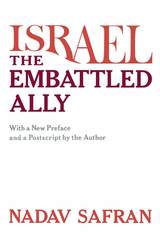 Israel, the Embattled Ally: With a New Preface and a Postscript by the Author
Nadav Safran
Harvard University Press, 1978 Through thirty turbulent years, the United States has been deeply enmeshed in Israel's destiny. Seldom in the history of international relations has such a world power been involved so intensely for so long with such a small power. How this phenomenon came to pass and how it will affect the future are explained in this compelling history of Israel and its relations with the United States—from the 1947 United Nations resolution through Kissinger's shuttle diplomacy to Carter's peace campaign.
To form the backdrop for this extraordinary relationship, Nadav Safran paints a detailed portrait of the historical forces that combined to create the Jewish state. He unfolds panel after panel of Israeli life—its physical environment, people, economy, politics, and religion. He examines Israel's responses to the many security crises it has faced since becoming a nation, and presents a clear and thorough exposition of its defense strategy and descriptions of all its wars.
Safran then presents his brilliant analysis of Israel and America in international politics. Cutting through the tangle of the Arab–Israeli conflict, the East–West struggle, the disagreement among Western powers, the conflicts within and among the Arab states, and the impact of special interest groups in the United States on its foreign policy, Safran deftly pursues fluctuations in the American–Israeli relationship as it moved from simple friendship to an alliance of friends. A concluding chapter recapitulates the highlights of that evolution and projects its relevance for the future of the Middle East and American–Israeli relations.
Israel, the United States, and the War Against Hamas, July–August 2014: The “Special Relationship” under Scrutiny
Zaki Shalom
Sussex Academic Press, 2022 Launched in 2014, "Operation Protective Edge" saw heavy fighting between the Israel Defense Forces and Hamas in Gaza. The US government media spokespersons confirmed Israel's right to self-defense, and condemned Hamas for initiating the conflict and its use of human shields. However, US government public criticisms relating to Gazan civilian loss of life damaged Israel on the international stage. Political and military policies have to be directed to prevent a rift, but the "Protective Edge" experience brought to the fore that in times of crisis Israel cannot rely on a "special relationship" to secure its safety. It must possess the political will and military ability to take actions that may result in a strained relationship.
Israel, the United States, and the War Against Hamas, July–August 2014: The “Special Relationship” under Scrutiny
Zaki Shalom
Sussex Academic Press, 2022 Launched in 2014, "Operation Protective Edge" saw heavy fighting between the Israel Defense Forces and Hamas in Gaza. The US government media spokespersons confirmed Israel's right to self-defense, and condemned Hamas for initiating the conflict and its use of human shields. However, US government public criticisms relating to Gazan civilian loss of life damaged Israel on the international stage. Political and military policies have to be directed to prevent a rift, but the "Protective Edge" experience brought to the fore that in times of crisis Israel cannot rely on a "special relationship" to secure its safety. It must possess the political will and military ability to take actions that may result in a strained relationship.
 Israel under Siege: The Politics of Insecurity and the Rise of the Israeli Neo-Revisionist Right
Raffaella A. Del Sarto
Georgetown University Press, 2017 Raffaella A. Del Sarto examines the creation of Israel's neo-revisionist consensus about security threats and regional order, which took hold of Israeli politics and society after 2000 and persists today. The failed Oslo peace process and the trauma of the Second Palestinian Intifada triggered this shift to the right; conflicts with Hamas and Hezbollah and the inflammatory rhetoric of Iranian President Ahmadinejad additionally contributed to the creation of a general sense of being under siege. While Israel faces real security threats, Israeli governments have engaged in the politics of insecurity, promoting and amplifying a sense of besiegement. Lively political debate has been replaced by a general acceptance of the no-compromise approach to security and the Palestinians. The neo-revisionist right, represented by Benjamin Netanyahu and the Likud, has turned Israel away from the peace process and pushes maximalist territorial ambitions. But they have failed to offer a vision for an end to conflict, and there has been little debate about whether or not the hardline policies toward the region are counterproductive. Del Sarto explains this disappearance of dissent and examines the costs of Israel’s policies. She concludes that Israel’s feeling of being under siege has become entrenched, a two-state solution with the Palestinians is highly unlikely for the foreseeable future, and Israel’s international isolation is likely to increase. Del Sarto’s analysis of this tense political situation will interest scholars and students of the Israeli-Palestinian conflict, Middle East Studies, and International Relations.
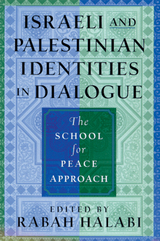 Israeli and Palestinian Identities in Dialogue: The School for Peace Approach
Edited by Rabah Halabi
Rutgers University Press, 2004 Israeli Palestinians make up about 20 percent of Israeli citizens and, for the most part, live separate lives from their Jewish neighbors—lives fraught with political, social, and economic divisions. Attempts to initiate interactions between Palestinians and Jews outside official frameworks have often dissolved under political and economic pressures.
One lasting effort began when the School for Peace was established in 1976 in Neve Shalom/Wahat al-Salam, a joint model village set up in 1972 by a group of Jewish and Palestinian Israelis. Since its inception, the School for Peace has conducted hundreds of encounter activities to help create a more authentic and egalitarian dialogue between the Palestinian minority and Jewish majority.
This volume is the product of the insight and experiences of both Arabs and Jews at the School for Peace over the last two decades. Essays address topics such as strategies for working with young people, development of effective learning environments for conflict resolution, and language as a bridge and as an obstacle. It is the first book to provide a model for dialogue between Palestinians and Jews that has been used successfully in other ethnic and national conflicts, and should be required reading for everyone interested in Jewish-Palestinian relations.
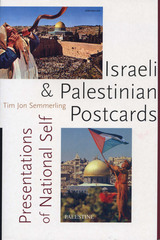 Israeli and Palestinian Postcards: Presentations of National Self
By Tim Jon Semmerling
University of Texas Press, 2004 Searing images of suicide bombings and retaliatory strikes now define the Israeli-Palestinian conflict for many Westerners, but television and print media are not the only visual realms in which the conflict is playing out. Even tourist postcards and greeting cards have been pressed into service as vehicles through which Israelis and Palestinians present competing visions of national selfhood and conflicting claims to their common homeland. In this book, Tim Jon Semmerling explores how Israelis and Palestinians have recently used postcards and greeting cards to present images of the national self, to build national awareness and reinforce nationalist ideologies, and to gain international acceptance. He discusses and displays the works of numerous postcard/greeting card manufacturers, artists, and photographers and identifies the symbolic choices in their postcards, how the choices are arranged into messages, what the messages convey and to whom, and who benefits and loses in these presentations of national self. Semmerling convincingly demonstrates that, far from being ephemeral, Israeli and Palestinian postcards constitute an important arena of struggle over visual signs and the power to produce reality.
Israeli Apartheid: A Beginner's Guide
Ben White
Pluto Press, 2014 * Shortlisted for the Palestine Book Awards 2012*
Since its release in 2009 Israeli Apartheid: A Beginner's Guide has become an essential primer for undergraduate students and activists getting to grips with the Palestine/Israel conflict for the first time. Ben White skilfully distills the work of academics and experts into a highly accessible introduction.
This new updated and expanded edition includes information on the Israeli blockade and attacks on the Gaza Strip since 2008, new policies targeting Palestinian citizens of Israel and the growth of the global Boycott Divestment Sanctions campaign.
Packed with vital information, quotations and resources, Israeli Apartheid never loses the human touch. The book is rooted in the author's extensive personal experience in Palestine and includes testimonies by Palestinians describing how Israeli apartheid affects their daily lives.
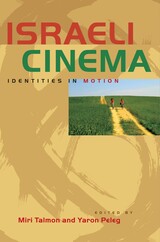 Israeli Cinema: Identities in Motion
Edited by Miri Talmon and Yaron Peleg
University of Texas Press, 2011 With top billing at many film forums around the world, as well as a string of prestigious prizes, including consecutive nominations for the Best Foreign Film Oscar, Israeli films have become one of the most visible and promising cinemas in the first decade of the twenty-first century, an intriguing and vibrant site for the representation of Israeli realities. Yet two decades have passed since the last wide-ranging scholarly overview of Israeli cinema, creating a need for a new, state-of-the-art analysis of this exciting cinematic oeuvre. The first anthology of its kind in English, Israeli Cinema: Identities in Motion presents a collection of specially commissioned articles in which leading Israeli film scholars examine Israeli cinema as a prism that refracts collective Israeli identities through the medium and art of motion pictures. The contributors address several broad themes: the nation imagined on film; war, conflict, and trauma; gender, sexuality, and ethnicity; religion and Judaism; discourses of place in the age of globalism; filming the Palestinian Other; and new cinematic discourses. The authors' illuminating readings of Israeli films reveal that Israeli cinema offers rare visual and narrative insights into the complex national, social, and multicultural Israeli universe, transcending the partial and superficial images of this culture in world media.
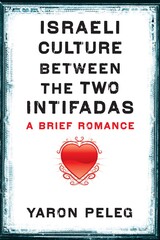 Israeli Culture between the Two Intifadas: A Brief Romance
By Yaron Peleg
University of Texas Press, 2008 Over the past two decades, profound changes in Israel opened its society to powerful outside forces and the dominance of global capitalism. As a result, the centrality of Zionism as an organizing ideology waned, prompting expressions of anxiety in Israel about the coming of a post-Zionist age. The fears about the end of Zionism were quelled, however, by the Palestinian uprising in 2000, which spurred at least a partial return to more traditional perceptions of homeland. Looking at Israeli literature of the late twentieth century, Yaron Peleg shows how a young, urban class of Israelis felt alienated from the Zionist values of their forebears, and how they adopted a form of escapist romanticism as a defiant response that replaced traditional nationalism. One of the first books in English to identify the end of the post-Zionist era through inspired readings of Hebrew literature and popular media, Israeli Culture between the Two Intifadas examines Israel's ambivalent relationship with Jewish nationalism at the end of the twentieth century.
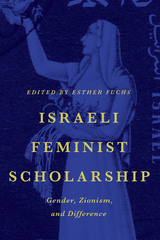 Israeli Feminist Scholarship: Gender, Zionism, and Difference
Edited by Esther Fuchs
University of Texas Press, 2014 The last two decades have given rise to a proliferation of scholarship by Israeli feminists working in diverse fields, ranging from sociology to literature, anthropology, and history. As the Israeli feminist movement continually decentralizes and diversifies, it has become less Eurocentric and heterocentric, making way for pluralistic concerns. Collecting fifteen previously published essays that give voice to this diversity, Israeli Feminist Scholarship showcases articles on Ashkenazi, Mizrahi, Palestinian, and lesbian identities as well as on Israeli women’s roles as mothers, citizens and activists, and soldiers. Citing evidence that these scholars have redefined their object of inquiry as an open site of contested and constructed identity, luminary Esther Fuchs traces the history of Israeli feminism. Among the essays are Jewish historian Margalit Shilo’s study of the New Hebrew Woman, sociologist Ronit Lentin’s analysis of gendered representations of the Holocaust in Israeli culture, peace activist Erella Shadmi on lesbianism as a nonissue in Israel, and cultural critic Nitza Berkovitch’s examination of womanhood as constructed in Israeli legal discourse. Creating a space for a critical examination of the relationship between disparate yet analogous discourses within feminism and Zionism, this anthology reclaims the mobilizing, inclusive role of these multifaceted discourses beyond the postmodern paradigm.
 An Israeli in Palestine: Resisting Dispossession, Redeeming Israel
Jeff Halper
Pluto Press, 2010 Israeli anthropologist and activist Jeff Halper throws a harsh light on the Israeli-Palestinian conflict from the point of view of a critical insider. While the Zionist founders of Israel created a vibrant society, culture and economy, they did so at a high price: Israel could not maintain its exclusive Jewish character without imposing on the country's Palestinian population policies of ethnic cleansing, occupation and discrimination, expressed most graphically in its ongoing demolition of thousands of Palestinian homes, both inside Israel and in the Occupied Territories.
An Israeli in Palestine records Halper's journey 'beyond the membrane' that shields his people from the harsh realities of Palestinian life to his 'discovery' that he was actually living in another country: Palestine. Without dismissing the legitimacy of his own country, he realises that Israel is defined by its oppressive relationship to the Palestinians.
This second edition is includes an epilogue gauging the chances for peace after the failed Annapolis process.
 Israeli Rejectionism: A Hidden Agenda in the Middle East Peace Process
Zalman Amit
Pluto Press, 2011 The Palestine-Israel conflict is one of the longest running and seemingly intractable confrontations in the modern world. This book delves deep into the "peace process" to find out why so little progress has been made on the key issues. Zalman Amit and Daphna Levit find overwhelming evidence of Israeli rejectionism as the main cause for the failure of peace. They demonstrate that the Israeli leadership has always been against a fairly negotiated peace and have deliberately stalled negotiations for the last 80 years. The motivations behind this rejectionist position have changed, as have the circumstances of the conflict, but the conclusion has remained consistent_-- peace has not been in the interest of the state of Israel. A fascinating read, and particularly timely as the Obama administration tries once more for a peace settlement, this book draws on a wealth of sources_-- including Hebrew documents and transcripts -- to show that it is the Palestinians who lack a viable "partner for peace."
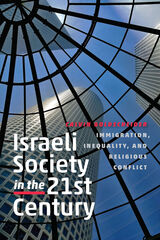 Israeli Society in the Twenty-First Century: Immigration, Inequality, and Religious Conflict
Calvin Goldscheider
Brandeis University Press, 2015 This volume illuminates changes in Israeli society over the past generation. Goldscheider identifies three key social changes that have led to the transformation of Israeli society in the twenty-first century: the massive immigration of Jews from the former Soviet Union, the economic shift to a high-tech economy, and the growth of socioeconomic inequalities inside Israel. To deepen his analysis of these developments, Goldscheider focuses on ethnicity, religion, and gender, including the growth of ethnic pluralism in Israel, the strengthening of the Ultra-Orthodox community, the changing nature of religious Zionism and secularism, shifts in family patterns, and new issues and challenges between Palestinians and Arab Israelis given the stalemate in the peace process and the expansions of Jewish settlements. Combining demography and social structural analysis, the author draws on the most recent data available from the Israeli Central Bureau of Statistics and other sources to offer scholars and students an innovative guide to thinking about the Israel of the future. This book will be of interest to scholars and students of contemporary Israel, the Middle East, sociology, demography and economic development, as well as policy specialists in these fields. It will serve as a textbook for courses in Israeli history and in the modern Middle East.
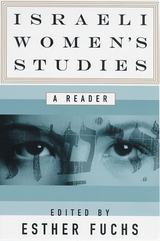 Israeli Women's Studies: A Reader
Edited by Esther Fuchs
Rutgers University Press, 2005 Israeli women do not enjoy the equality, status, and power often attributed to them by the media and popular culture. Despite significant achievements and progress, as a whole they continue to earn less than their male counterparts, are less visible and influential in the political arena, do not share equal responsibilities or privileges in the military, have unequal rights and freedoms in family life and law, and are less influential in shaping the nation's self image and cultural orientation. Bringing together classic essays by leading scholars of Israeli culture, this reader exposes the hidden causes of ongoing discrimination and links the restrictions that Israeli women experience to deeply entrenched structures, including colonial legacies, religious traditions, capitalism, nationalism, and ongoing political conflict. In contrast, the essays also explore how women act creatively to affect social change and shape public discourse in less ostensible ways. Providing balanced perspectives from the social sciences and the humanities, this comprehensive reader reflects both an emerging consensus and exciting diversity in the field. It is the definitive text for courses in Israeli women's studies.
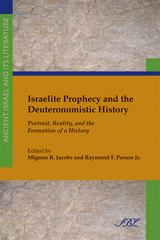 Israelite Prophecy and the Deuteronomistic History: Portrait, Reality, and the Formation of a History
Mignon R. Jacobs
SBL Press, 2013 This collection of essays examines the relationship of prophecy to the Deuteronomistic History (Deuteronomy–2 Kings), including the historical reality of prophecy that stands behind the text and the portrayal of prophecy within the literature itself. The contributors use a number of perspectives to explore the varieties of intermediation and the cultic setting of prophecy in the ancient Near East; the portrayal of prophecy in pentateuchal traditions, pre-Deuteronomistic sources, and other Near Eastern literature; the diverse perspectives reflected within the Deuteronomistic History; and the possible Persian period setting for the final form of the Deuteronomistic History. Together the collection represents the current state of an important, ongoing discussion.
The contributors are Ehud Ben Zvi, Diana Edelman, Mignon R. Jacobs, Mark Leuchter, Martti Nissinen, Mark O’Brien, Raymond F. Person Jr., Thomas C. Römer, Marvin A. Sweeney, and Rannfrid Thelle.
 Israel/Palestine and the Queer International
Sarah Schulman
Duke University Press, 2012 In this chronicle of political awakening and queer solidarity, the activist and novelist Sarah Schulman describes her dawning consciousness of the Palestinian liberation struggle. Invited to Israel to give the keynote address at an LGBT studies conference at Tel Aviv University, Schulman declines, joining other artists and academics honoring the Palestinian call for an academic and cultural boycott of Israel. Anti-occupation activists in the United States, Canada, Israel, and Palestine come together to help organize an alternative solidarity visit for the American activist. Schulman takes us to an anarchist, vegan café in Tel Aviv, where she meets anti-occupation queer Israelis, and through border checkpoints into the West Bank, where queer Palestinian activists welcome her into their spaces for conversations that will change the course of her life. She describes the dusty roads through the West Bank, where Palestinians are cut off from water and subjected to endless restrictions while Israeli settler neighborhoods have full freedoms and resources. As Schulman learns more, she questions the contradiction between Israel's investment in presenting itself as gay friendly—financially sponsoring gay film festivals and parades—and its denial of the rights of Palestinians. At the same time, she talks with straight Palestinian activists about their position in relation to homosexuality and gay rights in Palestine and internationally. Back in the United States, Schulman draws on her extensive activist experience to organize a speaking tour for some of the Palestinian queer leaders whom she had met and trusted. Dubbed "Al-Tour," it takes the activists to LGBT community centers, conferences, and universities throughout the United States. Its success solidifies her commitment to working to end Israel's occupation of Palestine, and it kindles her larger hope that a new "queer international" will emerge and join other movements demanding human rights across the globe.
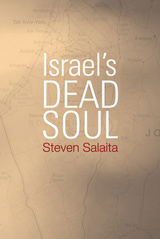 Israel's Dead Soul
Authored by Steven Salaita
Temple University Press, 2011 In his courageous book, Israel's Dead Soul, Steven Salaita explores the failures of Zionism as a political and ethical discourse. He argues that endowing nation-states with souls is a dangerous phenomenon because it privileges institutions and corporations rather than human beings.
Asserting that Zionism has been normalized--rendered "benign" as an ideology of "multicultural conviviality"—Salaita critiques the idea that Zionism, as an exceptional ideology, leads to a lack of critical awareness of the effects of the Israeli occupation in Palestinian territory and to an unquestioning acceptance of Israel as an ethnocentric state.
Salaita's analysis targets the Anti-Defamation League, films such as Munich and Waltz with Bashir, intellectuals including Cornel West and Michael Eric Dyson, gay rights activists, and other public figures who mourn the decline of Israel's "soul." His pointed account shows how liberal notions of Zionism are harmful to various movements for justice.
 Israel's Long War with Hezbollah: Military Innovation and Adaptation Under Fire
Raphael D. Marcus
Georgetown University Press, 2018 The ongoing conflict between Israel and the Lebanese militant group Hezbollah is now in its fourth decade and shows no signs of ending. Raphael D. Marcus examines this conflict since the formation of Hezbollah during Israel’s occupation of Lebanon in the early 1980s. He critically evaluates events including Israel’s long counterguerrilla campaign throughout the 1990s, the Israeli withdrawal in 2000, the 2006 summer war, and concludes with an assessment of current tensions on the border between Israel and Lebanon related to the Syrian civil war. Israel’s Long War with Hezbollah is both the first complete military history of this decades-long conflict and an analysis of military innovation and adaptation. The book is based on unique fieldwork in Israel and Lebanon, extensive research into Hebrew and Arabic primary sources, and dozens of interviews Marcus conducted with Israeli defense officials, high-ranking military officers of the Israel Defense Forces (IDF), United Nations personnel, a Hezbollah official, and Western diplomats. As an expert on organizational learning, Marcus analyzes ongoing processes of strategic and operational innovation and adaptation by both the IDF and Hezbollah throughout the long guerrilla conflict. His conclusions illuminate the dynamics of the ongoing conflict and illustrate the complexity of military adaptation under fire. With Hezbollah playing an ongoing role in the civil war in Syria and the simmering hostilities on the Israel-Lebanon border, students, scholars, diplomats, and military practitioners with an interest in Middle Eastern security issues, Israeli military history, and military innovation and adaptation can ill afford to neglect this book.
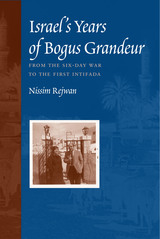 Israel's Years of Bogus Grandeur: From the Six-Day War to the First Intifada
By Nissim Rejwan
University of Texas Press, 2006 On the eve of the Six-Day War in 1967, Israel was nineteen years old and as much an adolescent as the average nineteen-year-old person. Issues of identity and transition were the talk among Israeli intellectuals, including the writer Nissim Rejwan. Was Israel a Jewish state or a democratic state? And, most frustratingly, who was a Jew? As Nancy Berg's foreword makes clear, these issues became more critical and complex in the two decades after the war as Israel matured into a regional power. Rejwan, an Iraqi-born Jew whose own fate was tied to the answers, addresses the questions of those days in his letters, essays, and remembrances collected in Israel's Years of Bogus Grandeur.
Israel's overwhelming victory in 1967 brought control of the former Palestinian territories; at the same time, Oriental Jews (i.e., those not from Europe) became a majority in the Israeli population. The nation, already surrounded by hostile, recently humiliated Arab neighbors, now had an Arab majority (Jewish, Muslim, Druze, and Christian) within its borders—yet European Jews continued to run the country as their own. Rejwan wrote tirelessly about the second-class status of Arab Israelis (and especially of Arab Jews), encouraging a more inclusive attitude that might eventually help heal the wounds left by the Six-Day War. His studies in sociology at Tel Aviv University informed his work. For his cause, Rejwan lost his job and many of his friends but never his pen. Through Munich, Entebbe, political scandals, economic crises, and the beginning of the Intifada, Rejwan narrates Israel's growing pains with feisty wit and unwavering honesty.
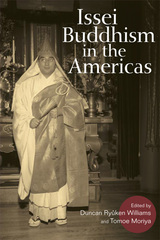 Issei Buddhism in the Americas
Edited by Duncan Ryuken Williams and Tomoe Moriya
University of Illinois Press, 2010 Rich in primary sources and featuring contributions from scholars on both sides of the Pacific, Issei Buddhism in the Americas upends boundaries and categories that have tied Buddhism to Asia and illuminates the social and spiritual role that the religion has played in the Americas. While Buddhists in Japan had long described the migration of the religion as traveling from India, across Asia, and ending in Japan, this collection details the movement of Buddhism across the Pacific to the Americas. Leading the way were pioneering, first-generation Issei priests and their followers who established temples, shared Buddhist teachings, and converted non-Buddhists in the late nineteenth and twentieth centuries. The book explores these pioneering efforts in the context of Japanese diasporic communities and immigration history and the early history of Buddhism in the Americas. The result is a dramatic exploration of the history of Asian immigrant religion that encompasses such topics as Japanese language instruction in Hawaiian schools, the Japanese Canadian community in British Columbia, the roles of Buddhist song culture, Tenriyko ministers in America, and Zen Buddhism in Brazil. Contributors are Michihiro Ama, Noriko Asato, Masako Iino, Tomoe Moriya, Lori Pierce, Cristina Rocha, Keiko Wells, Duncan Ryûken Williams, and Akihiro Yamakura.
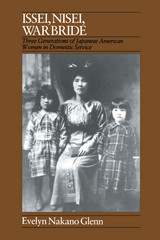 Issei, Nisei, War Bride: Three Generations of Japanese American Women in Domestic Service
Evelyn Nakano Glenn
Temple University Press, 1988 Three Generations of Japanese American Women in Domestic Service
Evelyn Nakano Glenn
"A richly detailed and sophisticated examination of...how historical and economic forces restricted women's lives and how women devised strategies for dealing with their plight."
--Canadian Woman Studies
In this unique study of Japanese American women employed as domestic workers, Evelyn Nakano Glenn reveals through historical research and in-depth interviews how the careers of these strong but oppressed women affected the history of Asian immigration in the San Francisco-Bay Area. Three generations of women speak in their own words about coping with degraded employment and how this work related to family and community life.
The disproportionate concentration of Japanese American women in domestic service from the early part of this century to the present resulted from their status as immigrants and women of color in a race and gender stratified local labor market. The three generations covered by this study--pre-1924 immigrants (issei), first American born generation (nisei), and post-World War II immigrants (war brides)--were subjected to multiple forms of oppression but were not appendages of men nor passive victims. Dr. Glenn shows how their struggles to achieve autonomy, dignity, and a suitable livelihood were essential to the survival of the family and the community.
Although unique in many ways, the situation of the Japanese American woman has important parallels with that of other women of color in the United States. Ironically her role as a domestic cast her in a menial, degraded job but often elevated her to the position of valued confidant to her employer. Issei, Nisei, War Bride is the first study to offer a sociological/historical perspective on these women. It addresses issues about the nature of labor systems in capitalist economies, the role of immigrant and racial ethnic women in those systems, and the consequences of participation in race and gender stratified systems for minority families and communities.
Reviews
"A beautifully written, well-organized, and sociologically rich study of three generations of Japanese-American women who worked as domestics. Glenn's study fits well into a women's studies collection, particularly with those materials focusing on immigrants or the working class."
--Choice
"... A much welcome contribution to the literature on women and work and on Japanese American women, in particular. Glenn has artfully combined a rich case study approach with detailed sociodemographics in an historical framework.... Glenn writes well and skillfully incorporates detailed historical and demographic facts with a descriptive style. The presentation of labor statistics is excellent.... This book is an important contribution, not only to Asian American Studies but to women's studies and the literature on labor and immigrant groups."
--Amerasia Journal
"A revealing view into the role of Japanese women immigrants in the United States not only as domestic workers but also in their family lives. This study is enlivened by the life stories and quotations from the women themselves..."
--Edwin O. Reischauer
"This work is a valuable contribution to the literature on immigration and an important addition to the literature on occupations. It contains a fascinating and highly readable account of the array of perspectives on work and family that Glenn was uniquely positioned to collect from Japanese women and provides an extremely useful study for those who teach women and work, gender roles, and sociology of occupations courses."
--Arlene Kaplan Daniels
About the Author(s)
Evelyn Nakano Glenn is Associate Professor of Sociology at State University of New York at Binghamton.
Issue Mapping for an Ageing Europe
Edited by Richard Rogers, Natalia Sánchez-Querubín, and Aleksandra Kil
Amsterdam University Press, 2015 Issue Mapping for an Ageing Europe is a seminal guide to mapping social and political issues with digital methods. The issue at stake concerns the imminent crisis of an ageing Europe and its impact on the contemporary welfare state. The book brings together three leading approaches to issue mapping: Bruno Latour's social cartography, Ulrich Beck's risk cartography and Jeremy Crampton's critical neo-cartography. These modes of inquiry are put into practice with digital methods for mapping the ageing agenda, including debates surrounding so-called 'old age', cultural philosophies of ageing, itinerant care workers, not to mention European anti-ageing cuisine. Issue Mapping for an Ageing Europe addresses an urgent social issue with new media research tools.
The Issue of Blackness
Susan Stryker and Paisley Currah, special issue editors
Duke University Press This issue explores and questions the issuance of blackness to transgender identity, politics, and transgender studies. The editors ask why, in its processes of institutionalization and canon formation, transgender studies have been so remiss in acknowledging women-of-color feminisms—black feminisms in particular—as a necessary foundation for the field's own critical explorations of embodied difference. The essays also wrestle with the relationship between trans* studies and queer studies through the lens of blackness.
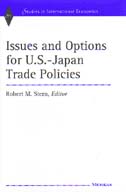 Issues and Options for U.S.-Japan Trade Policies
Robert M. Stern, Editor
University of Michigan Press, 2002 Because of the close links between the United States and Japan in trade, foreign direct investment, financial flows, exchange rates, international prices, and government policies, it is important to develop a better understanding of these links and how they may be turned to the advantage of all involved by improvements in the international policy environment. This book deals with the potential for such improvements as part of formal government-to-government negotiations in the multilateral context in the World Trade Organization (WTO), regionally in the Asia-Pacific Economic Cooperation (APEC) forum, and bilaterally with the administration of national trade laws and the negotiation of free trade agreements.
The chapters represent a spectrum of approaches, including theoretical analysis, quantitative measurement, and evaluations of policies and institutions from economic and legal perspectives. The multi-lateral issues cover the analysis of the economic effects of a new WTO negotiating round and the range of issues that are to be addressed there, including reform of Japan's agricultural policies, services liberalization, antidumping, intellectual property rights, and trade and the environment. The regional issues include theoretical and simulation analysis of the benefits of preferential trading arrangements and the policy of open regionalism that is being sought by APEC members. U.S.-Japan bilateral relations are studied by analyzing the major actions and positions taken by the two nations in the context of their national trade laws and policies, how trade policies are implemented, the effects of bilateral trade agreements on the United States and Japan, and the interplay of legal decisions reached in WTO actions with bilateral and unilateral measures undertaken by the two nations.
The book is designed for a broad audience consisting of academic economists, lawyers, policymakers, and students interested in U.S.-Japan international economic relations.
Robert M. Stern is Professor Emeritus of Economics and Public Policy, University of Michigan.
 Issues in Curating Contemporary Art and Performance
Edited by Judith Rugg and Michèle Sedgwick
Intellect Books, 2007 To stay relevant, art curators must keep up with the rapid pace of technological innovation as well as the aesthetic tastes of fickle critics and an ever-expanding circle of cultural arbiters. Issues in Curating Contemporary Art and Performance argues that, despite these daily pressures, good curating work also requires more theoretical attention. In four thematic sections, a distinguished group of contributors consider curation in light of interdisciplinary and emerging practices, examine conceptions of curation as intervention and contestation, and explore curation’s potential to act as a reconsideration of conventional museum spaces. Against the backdrop of cutting-edge developments in electronic art, art/science collaboration, nongallery spaces, and virtual fields, contributors propose new approaches to curating and new ways of fostering critical inquiry. Now in paperback, this volume is an essential read for scholars, curators, and art enthusiasts alike.
Issues in Curriculum: Selected Essays from Past NSSE Yearbooks
Edited by Margaret Early and Kenneth J. Rehage
University of Chicago Press, 1999 In response to a request from the NSSE Board of Directors, the editors have brought together chapters from recent NSSE yearbooks that deal with problems of continuing concern to teachers, administrators, and specialists in curriculum development, including the problem of bringing about change in the curriculum. A recurring theme is the importance of taking account of the culture of the school when considering proposals or curriculum change. A valuable resource as a guide to thinking about persistent curriculum issues, this volume deserves a place on every educator's bookshelf.
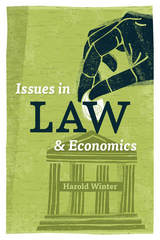 Issues in Law and Economics
Harold Winter
University of Chicago Press, 2017 Is file-sharing destroying the music industry? Should the courts encourage breach of contract? Does the threat of malpractice lawsuits cause doctors to provide too much medical care? Do judges discriminate when sentencing? With Issues in Law and Economics, Harold Winter takes readers through these and other recent and controversial questions. In an accessible and engaging manner, Winter shows these legal issues can be reexamined through the use of economic analysis. Using real-world cases to highlight issues, Winter offers step-by-step analysis, guiding readers through the identification of the trade-offs involved in each issue and assessing the economic evidence from scholarly research before exploring how this research may be used to guide policy recommendations. The book is divided into four sections, covering the basic practice areas of property, contracts, torts, and crime, with a fifth section devoted to a concise introduction to the topic of behavioral law and economics. Each chapter concludes with a series of thought-provoking discussion questions that provide readers the opportunity to further explore important ideas and concepts.
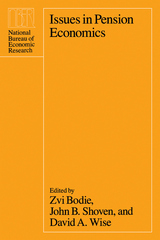 Issues in Pension Economics
Edited by Zvi Bodie, John B. Shoven, and David A. Wise
University of Chicago Press, 1987 In the past several decades, pension plans have become one of the most significant institutional influences on labor and financial markets in the U.S. In an effort to understand the economic effects of this growth, the National Bureau of Economic Research embarked on a major research project in 1980. Issues in Pension Economics, the third in a series of four projected volumes to result from thsi study, covers a broad range of pension issues and utilizes new and richer data sources than have been previously available.
The papers in this volume cover such issues as the interaction of pension-funding decisions and corporate finances; the role of pensions in providing adequate and secure retirement income, including the integration of pension plans with social security and significant drops in the U.S. saving rate; and the incentive effects of pension plans on labor market behavior and the implications of plans on labor market behavior and the implications of plans for different demographic groups.
Issues in Pension Economics offers important empirical studies and makes valuable theoretical contributions to current thinking in an area that will most likely continue to be a source of controversy and debate for some time to come. The volume should prove useful to academics and policymakers, as well as to members of the business and labor communities.
Issues in Race and Society: An Interdisciplinary Global Journal: Complete 2019
Association of Black Sociologists
University of Cincinnati Press, 2019 As the official resource of ABS, Issues in Race & Society is a double-blind, peer-reviewed academic journal. The biannual journal distinguishes itself as an interdisciplinary, comprehensive, and global examination of the increasingly racial and racialized world that connects us all. It provides a space where all voices can be heard and diverse conversations can occur about the relationship and interconnections between race, power, privilege, and location operating across cultures and societies.
Issues in Race and Society: An Interdisciplinary Global Journal: Spring 2020, Special Issue on the Global Black Middle Class
Association of Black Sociologists
University of Cincinnati Press, 2020 As the official resource of ABS, Issues in Race & Society is a double-blind, peer-reviewed academic journal. The biannual journal distinguishes itself as an interdisciplinary, comprehensive, and global examination of the increasingly racial and racialized world that connects us all. It provides a space where all voices can be heard and diverse conversations can occur about the relationship and interconnections between race, power, privilege, and location operating across cultures and societies.
Issues in Race and Society: An Interdisciplinary Global Journal: Spring 2021
Association of Black Sociologists
University of Cincinnati Press, 2021 As the official resource of ABS, Issues in Race & Society is a double-blind, peer-reviewed academic journal. The biannual journal distinguishes itself as an interdisciplinary, comprehensive, and global examination of the increasingly racial and racialized world that connects us all. It provides a space where all voices can be heard and diverse conversations can occur about the relationship and interconnections between race, power, privilege, and location operating across cultures and societies.
Issues in the Economics of Aging
Edited by David A. Wise
University of Chicago Press, 1990 This companion volume to The Economics of Aging (1989) examines the economic consequences of an increasingly older population, focusing on the housing and living arrangements of the elderly, as well as their labor force participation and retirement.
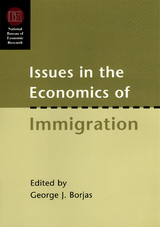 Issues in the Economics of Immigration
Edited by George J. Borjas
University of Chicago Press, 2000 The United States is now admitting nearly one million legal immigrants per year, while the flow of illegal aliens into the country continues to increase steadily. The debate over immigration policy has typically focused on three fundamental questions: How do immigrants perform economically relative to others? What effects do immigrants have on the employment opportunities of other workers? What kind of immigration policy is most beneficial to the host country? This authoritative volume represents a move beyond purely descriptive assessments of labor market consequences toward a more fully developed analysis of economic impacts across the social spectrum. Exploring the broader repercussions of immigration on education, welfare, Social Security, and crime, as well as the labor market, these papers assess dimensions not yet taken into account by traditional cost-benefit calculations.
This collection offers new insights into the kinds of economic opportunities and outcomes that immigrant populations might expect for themselves and future generations.
Issues in the Phonology and Morphology of the Major Iberian Languages
Fernando Martinez-Gil and Alfonso Morales-Front, Editors
Georgetown University Press, 1997 This collection explores current issues in the phonology and morphology of the major Iberian languages: Basque, Catalan, Galician, Portuguese, and Spanish. Most of the essays are based on innovative theoretical frameworks and show how recent revolutions in theoretical ideas have affected the study of these languages. Distinguished scholars address a diverse range of topics, including: stress assignment, phonological variability, distribution of rhotics, the imperative paradigm, focus, pluralization, spirantization, intonation, prosody, apocope, epenthesis, palatalization, and depalatalization.
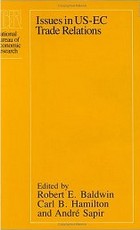 Issues in US-EC Trade Relations
Edited by Robert E. Baldwin, Carl B. Hamilton, and André Sapir
University of Chicago Press, 1988 A viable system of international trade requires the active support of both the United States and the European Community, the world's largest trading partners and, consequently, the primary forces shaping the post-World War II international trading regime. In recent years, however, a series of disagreements have threatened the consensus supporting that regime. Differences have arisen over the relation of trade policy to balance-of-trade deficits, the terms of and actual compliance with the current General Agreement on Tariffs and Trade, and the proper agenda and procedures to be adopted in future multilateral trade negotiations. These differences, if left unresolved, will further weaken an already strained system.
Issues in US-EC Trade Relations presents the results of a conference organized by the NBER and the Centre for European Policy Studies. In it, North American and European trade specialists offer theoretical, empirical, and historical analyses of some of the major issues on which American and Community officials disagree and also formulate realistic policies for settling present disputes. Contributors consider such topics as the legal aspects of trade between the two regions, agricultural policy, different ways the United States and members of the European Community use embargoes to attempt to induce foreign countries to change particular political actions, the growing trend toward protectionism and responses to this policy, international trade in services, and trade policy in oligopolistic environments. In most cases, each general subject is approached from both an American and a European perspective.
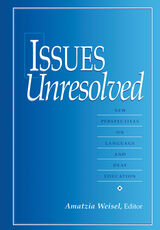 Issues Unresolved: New Perspectives on Language and Deaf Education
Amatzia Weisel
Gallaudet University Press, 1998 Of the more than 400 studies presented at the 18th International Congress on Education of the Deaf, the 20 most incisive papers were selected, rewritten, and edited to construct the trenchant volume Issues Unresolved: New Perspectives on Language and Deaf Education. The resulting book provocatively challenges the invested reader in four critical areas of deaf education worldwide.
Part 1, Communication: Signed and Spoken Languages, addresses matters that range from considering critical periods for language acquisition, researched by Susan D. Fischer, to assessing the impact of immigration policies on the ethnic composition of Australia’s deaf community, intriguing work by Jan Branson and Don Miller.
Part 2, Communication: Accessibility to Speech, continues the debate with works on the perception of speech by deaf and hard of hearing children, contributed by Arthur Boothroyd, and automatic speech recognition and its applications, delineated by Harry Levitt.
Educational issues are brought to the forefront in Part 3 in such engrossing studies as Lea Lurie and Alex Kozulin’s discourse on the application of an instrumental-enrichment cognitive intervention program with deaf immigrant children from Ethiopia. Stephen Powers offers another perspective in this section with his retrospective evaluation of a distance education training course for teachers of the deaf.
Part 4, Psychological and Social Adjustment reviews progress in this area, with Anne de Klerk’s exposition on the Rotterdam Deaf Awareness Program, and Corinne J. Lewkowitz and Lynn S. Liben’s research on the development of deaf and hearing children’s sex-role attitudes and self-endorsements. These and the many other contributions by renowned international scholars in the field make Issues Unresolved a compelling new standard for all involved in deaf education.
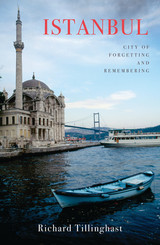 Istanbul: City of Forgetting and Remembering
Richard Tillinghast
Haus Publishing, 2017 With its varied and glorious history, Istanbul remains one of the world’s perennially fascinating cities. Richard Tillinghast, who first visited Istanbul in the early 1960s and has watched it transform over the decades into a vibrant metropolis, explores its rich art and architecture, culture, cuisine, and much more in this book.
Istanbul was known in Byzantine times as the “Queen of Cities” and to the Ottoman Turks as the “Abode of Felicity.” Steeped in Istanbul’s history, Tillinghast takes his readers on a voyage of discovery through this storied cultural hub, and he is as comfortable talking about Byzantine mosaics and dervish ceremonies as Iznik ceramics and the imperial mosques. His lyrical writing brings Istanbul alive on the page as he accompanies readers to cafés, palaces, and taverns, perfectly conjuring the atmospheric delights, sounds, and senses of the city. Illuminating Istanbul’s great buildings with tales that bring Ottoman and Byzantine history to life, Tillinghast is adept at discovering both what the city remembers and what it chooses to forget.
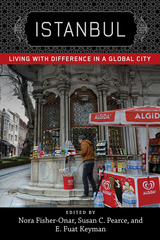 Istanbul: Living with Difference in a Global City
Fisher-Onar, Nora
Rutgers University Press, 2018 Istanbul explores how to live with difference through the prism of an age-old, cutting-edge city whose people have long confronted the challenge of sharing space with the Other. Located at the intersection of trade networks connecting Europe, Asia, and Africa, Istanbul is western and eastern, northern and southern, religious and secular. Heir of ancient empires, Istanbul is the premier city of a proud nation-state even as it has become a global city of multinational corporations, NGOs, and capital flows.
Rather than exploring Istanbul as one place at one time, the contributors to this volume focus on the city’s experience of migration and globalization over the last two centuries. Asking what Istanbul teaches us about living with people whose hopes jostle with one’s own, contributors explore the rise, collapse, and fragile rebirth of cosmopolitan conviviality in a once and future world city. The result is a cogent, interdisciplinary exchange about an urban space that is microcosmic of dilemmas of diversity across time and space.
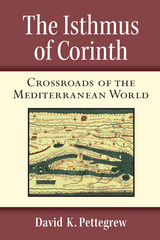 The Isthmus of Corinth: Crossroads of the Mediterranean World
David K. Pettegrew
University of Michigan Press, 2016 The narrow neck of land that joins the Peloponnese with the Greek mainland was central to the fortunes of the city of Corinth and the history of Greece from the classical Greek period to the end of the ancient world. Corinth was perfectly situated for monitoring land traffic between Athens and Sparta and overland movements between eastern and western seas.
David Pettegrew’s book offers a new history of the Isthmus of Corinth from the Romans’ initial presence in Greece during the Hellenistic era to the epic transformations of the Empire in late antiquity. A new interpretation of the extensive literary evidence outlines how the Isthmus became the most famous land bridge of the ancient world, central to maritime interests of Corinth, and a medium for Rome’s conquest, annexation, and administration in the Greek east. A fresh synthesis of archaeological evidence and the results of a recent intensive survey on the Isthmus describe the physical development of fortifications, settlements, harbors, roads, and sanctuaries in the region. The author includes chapters on the classical background of the concept isthmos, the sacking of Corinth and the defeat of the Achaean League, colonization in the Late Roman Republic, the Emperor Nero’s canal project and its failure, the growth of Roman settlement in the territory, and the end of athletic contests at Isthmia. The Isthmus of Corinth offers a powerful case study in the ways that shifting Mediterranean worlds transformed a culturally significant landscape over the course of a millennium.
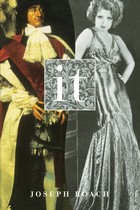 It
Joseph Roach
University of Michigan Press, 2011 A consumer’s guide to iconic celebrity and ageless glamour “Strikingly original, wickedly witty, and thoroughly learned, Roach’s anatomy of abnormally interesting people and the vicarious pleasure we take in our modern equivalents to gods and royals will captivate its readers from the first page. I dare you to read just one chapter!” —Felicity Nussbaum, University of California, Los Angeles “It considers the effect that arises when spectacularly compelling performers and cultural fantasy converge, as in the outpouring of public grief over the death of Princess Diana. . . . An important work of cultural history, full of metaphysical wit . . . It gives us a fresh vocabulary for interpreting how after-images endure in cultural memory.” —Andrew Sofer, Boston College “Joseph Roach’s enormous erudition, sharp wit, engaging style, and gift for finding the most telling historical detail or literary quote are here delightfully applied to the intriguing subject of why certain historical and theatrical figures have possessed a special power to fascinate their public.” —Marvin Carlson, Graduate Center, City University of New York That mysterious characteristic “It”—“the easily perceived but hard-to-define quality possessed by abnormally interesting people”—is the subject of Joseph Roach’s engrossing new book, which crisscrosses centuries and continents with a deep playfulness that entertains while it enlightens. Roach traces the origins of “It” back to the period following the Restoration, persuasively linking the sex appeal of today’s celebrity figures with the attraction of those who lived centuries before. The book includes guest appearances by King Charles II, Samuel Pepys, Flo Ziegfeld, Johnny Depp, Elinor Glyn, Clara Bow, the Second Duke of Buckingham, John Dryden, Michael Jackson, and Lady Diana, among others.
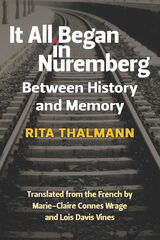 It All Began in Nuremberg: Between History and Memory
Rita Thalmann
University of Michigan Press, 2015 It All Began in Nuremberg is a translation of Rita Thalmann’s moving memoir, Tout Commença à Nuremberg, originally published in France in 2004. Thalmann’s memoir represents one of the last voices to witness personally the rise of Nazism and the Holocaust. The author, a scholar of significance in France, died on August 18, 2013. Rita Thalmann was born in Nuremberg in 1926 and lived there until 1933, when anti-Semitic events made life intolerable. Her father abandoned his successful business and moved the family to Switzerland, where they were unwelcome, and then to France. After settling in Dijon, Rita attended public school until Jews were no longer allowed to pursue an education. At age fourteen, she took private lessons in English at the home of her teacher, Henriette Connes, who saved Rita from deportation and death by providing her with false identification papers and passing her to the Free Zone with a group of students going on a field trip. Although Rita and her brother managed to escape to Switzerland during the war, most of her family died in the Holocaust. After the war, Rita Thalmann was determined to continue her education and participate in the struggle against anti-Semitism and discrimination of all types. She achieved the highest level of university teaching in France while publishing seven books. This memoir relates her personal experience of the historical events she spent most of her adult life researching.
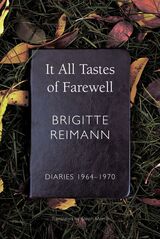 It All Tastes of Farewell: Diaries, 1964–1970
Brigitte Reimann
Seagull Books, 2016 Continuing where Reimann's earlier book of diaries, I Have No Regrets, left off, in 1964, this volume is a compelling and frank account of one woman’s life and loves in 1960s East Germany.
It All Tastes of Farewell is a frank account of one woman’s life and loves in 1960s East Germany. As a writer, Brigitte Reimann could not help but tell a compelling story, and that is born out here in her diaries, which are gripping as any novel. She recorded only what mattered: telling details, emotional truths, and political realities. Never written for publication and first published in full in German only after the fall of the Berlin Wall, these diaries offer a unique record of what it felt like to live in a country that no longer exists, was represented for years largely through Cold War propaganda, and is still portrayed in fairy-tale Stasi dramas. Here we get a sense of lived experience as if Doris Lessing or Edna O’Brien had been allowed in with their notebooks. This volume continues where her earlier book of diaries, I Have No Regrets, left off, in 1964. It sees Reimann grow wistful and at times bitter, as her love life, her professional life, and her health all suffer. Yet throughout she retains a lively appetite for new experiences and a dedication to writing. Finally, she finds security in a surprising new love, and although she died soon after this volume ends, the novel she was writing was to become a much-read cult hit after her death.
A remarkable document from a time and place that we still struggle to see clearly, It All Tastes of Farewell is unforgettable, a last gift from an essential writer.
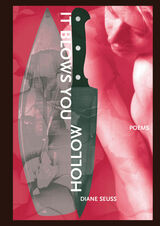 It Blows You Hollow
Diane Seuss
New Issues Poetry and Prose, 1998 With these dark, triumphant poems, Diane Seuss takes us on a journey through the landscape of the soul––and it’s a world full of beauty and violence in equal parts. Relentless and incantatory, these poems are charged with an almost religious intensity as Seuss looks for God’s presence in nature and sexuality. Again and again the poet confronts whatever it is that guides us through a life that is sensuous, yet exacting in its terrible cost.
Nothing is solved by the end of this book, but much is gained as the quest itself has become a victory of perfectly pitched and furious language. God’s still hidden away, but by now the natural world has evolved to replace the absence Seuss feels. In the book’s erotically charged universe, one paradoxically begins to feel a calm settle over the burned-up panorama of the soul. It Blows You Hollow is a book, rare these days, that feels as if it had to be written. Diane Seuss goes for broke.
 “It Changed My Life”: Writings on the Women’s Movement, With a New Introduction
Betty Friedan
Harvard University Press, 1998 “It changed my life.” That’s what Betty Friedan heard over and over from women throughout the United States after the publication of her radical best-seller, The Feminine Mystique, sparked the beginning of contemporary feminism. The first stirring and uncertain years of the women’s movement helped many women put a name to the sense of invisibility, powerlessness, and depression that Friedan famously called “the problem that has no name.”
First published in 1976, “It Changed My Life” is a compellingly readable collection of reports from the front, back in the days less than a generation ago when women were routinely shut out of the professions and higher education, underpaid, condescended to, and harassed without consequences to the harassers. The book describes the political campaigns for equal pay and job opportunities, for the outlawing of sex discrimination, for the Equal Rights Amendment, and for legalized abortion, the creation of National Organization for Women, the National Abortion Rights Action League, and the National Women’s Political Caucus, and analyzes the antifeminist backlashes. Encounters with Simone de Beauvoir and Indira Gandhi are juxtaposed with moving and vivid personal struggles of many ordinary women. Among those women was Friedan herself, who frankly recorded her astonishment, gratification, and anger as the movement she helped create grew beyond all her hopes, and then raced beyond her control into a sexual politics she found disturbing.
A classic of modern feminism, “It Changed My Life” brings back years of struggle for those who were there, and recreates the past for the readers of today who were not yet born during these struggles for the opportunities and respect to which women can now feel entitled. In changing women’s lives, the women’s movement has changed everything.
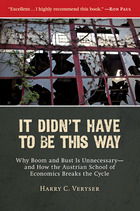 It Didn't Have to Be This Way: Why Boom and Bust Is Unnecessary—and How the Austrian School of Economics Breaks the Cycle
Harry C. Veryser
Intercollegiate Studies Institute, 2012
“Excellent . . . I highly recommend this book.” —RON PAUL
Why is the boom-and-bust cycle so persistent? Why did economists fail to predict the economic meltdown that began in 2007—or to pull us out of the crisis more quickly? And how can we prevent future calamities?
Mainstream economics has no adequate answers for these pressing questions. To understand how we got here, and how we can ensure prosperity, we must turn to an alternative to the dominant approach: the Austrian School of economics.
Unfortunately, few people have even a vague understanding of the Austrian School, despite the prominence of leading figures such as Nobel Prize winner F. A. Hayek, author of The Road to Serfdom. Harry C. Veryser corrects that problem in this powerful and eye-opening book. In presenting the Austrian School’s perspective, he reveals why the boom-and-bust cycle is unnatural and unnecessary.
Veryser tells the fascinating (but frightening) story of how our modern economic condition developed. The most recent recession, far from being an isolated incident, was part of a larger cycle that has been the scourge of the West for a century—a cycle rooted in government manipulation of markets and currency. The lesson is clear: the devastation of the recent economic crisis—and of stagflation in the 1970s, and of the Great Depression in the 1930s—could have been avoided. It didn’t have to be this way.
Economics is not a mysterious science, Veryser shows. As the Austrian School teaches, it is simply the study of human action. Mainstream economics has failed because it has forgotten this fundamental truth. Economists have tried to put economics on a par with hard sciences like physics, reducing everything to numbers. But their complex mathematical models and cherished theories have only contributed to economic collapse.
As the debate rages over the role of government in the economy, Harry Veryser presents the proper alternative to government interventionist approaches that have proved so ineffective. Too long unappreciated, the Austrian School of economics reveals the crucial conditions for a successful economy and points the way to a free, prosperous, and humane society.
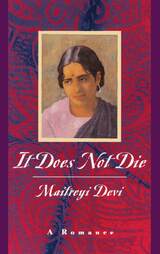 It Does Not Die: A Romance
Maitreyi Devi
University of Chicago Press, 1994 Precocious, a poet, a philosopher's daughter, Maitreyi Devi was sixteen years old in 1930 when Mircea Eliade came to Calcutta to study with her father. More than forty years passed before Devi read Bengal Nights, the novel Eliade had fashioned out of their encounter, only to find small details and phrases, even her given name, bringing back episodes and feelings she had spent decades trying to forget. It Does Not Die is Devi's response. In part a counter to Eliade's fantasies, the book is also a moving account of a first love fraught with cultural tensions, of false starts and lasting regrets.
Proud of her intelligence, Maitreyi Devi's father had provided her with a fine and, for that time, remarkably liberal education — and encouraged his brilliant foreign student, Eliade, to study with her. "We were two good exhibits in his museum," Devi writes. They were also, as it turned out, deeply taken with each other. When their secret romance was discovered, Devi's father banished the young Eliade from their home.
Against a rich backdrop of life in an upper-caste Hindu household, Devi powerfully recreates the confusion of an over-educated child simultaneously confronting sex and the differences, not only between European and Indian cultures, but also between her mother's and father's view of what was right. Amid a tangle of misunderstandings, between a European man and an Indian girl, between student and teacher, husband and wife, father and daughter, she describes a romance unfolding in the face of cultural differences but finally succumbing to cultural constraints. On its own, It Does Not Die is a fascinating story of cultural conflict and thwarted love. Read together with Eliade's Bengal Nights, Devi's "romance" is a powerful study of what happens when the oppositions between innocence and experience, enchantment and disillusion, and cultural difference and colonial arrogance collide.
"In two novels written forty years apart, a man and a woman tell stories of their love. . . . Taken together they provide an unusually touching story of young love unable to prevail against an opposition whose strength was tragically buttressed by the uncertainties of a cultural divide."—Isabel Colegate, New York Times Book Review
"Recreates, with extraordinary vividness, the 16-year-old in love that she had been. . . . Maitreyi is entirely, disarmingly open about her emotions. . . . An impassioned plea for truth."—Anita Desai, New Republic
"Something between a reunion and a duel. Together they detonate the classic bipolarities: East-West, life-art, woman-man."—Richard Eder, New York Newsday
"One good confession deserves another. . . . Both books gracefully trace the authors' doomed love affair and its emotional aftermath."—Nina Mehta, Chicago Tribune
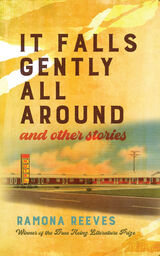 It Falls Gently All Around and Other Stories
Ramona Reeves
University of Pittsburgh Press, 2022 Winner, 2023 Sergio Troncoso Award for Best Book of Fiction, Texas Institute of Letters
Happiness and connection prove fickle in this debut collection of eleven linked stories introducing Babbie and Donnie. She is a thrice-divorced former call girl, and he is a sobriety-challenged trucker turned yogi. Along with their community of exes, in-laws, and coworkers, Babbie and Donnie share a longing to reforge their lives, a task easier said than done in Mobile, Alabama, which bears its own share of tainted history. Despite overwhelming challenges and the ever-looming specters of status, race, and class, the characters in It Falls Gently All Around and Other Stories strive for versions of the American dream through modern and often unconventional means. Told with humor and honesty, these stories remind us not only about the fallibility of being human and the resistance of some to change but also about finding redemption in unlikely places.
 It Had Been Planned and There Were Guides: Stories
Jessica Lee Richardson
University of Alabama Press, 2015 Winner of the FC2 Ronald Sukenick Innovative Fiction Prize
Jessica Lee Richardson’s debut collection It Had Been Planned and There Were Guides teems with double magic—families of spiders, monsters in triplicate, and panels of bleacher-sitting grandfathers (who live in a diaphragm!) cohabitate with a starker, more familiar kind of strange in a hyper real and living tapestry of teenage porn stars, lovelorn factory workers, and art world auctioneers. From a woman who awakes from a short kidnapping with an unquenchable need for risk to a concrete boat ride gone off the rails, from Los Angeles to the Bronx, from the Midwest to North Korea, these stories explore the absurd in real spaces and the real in absurd spaces, seeking a way into something else entirely.
Here, environments participate in agency, and voice compels movement forward, through, and in. Richly patterned language refuses singularity and the finger trap of the binary, seeking permeability in its reflection, a soft net to catch collective echoes. The collection begins and ends with stories that literalize descent and ascent, bookending the mirrored shape of the book’s arrangement as a vision of an inverted arc. The shape of story is literalized. We slide down from a mountaintop all the way to the inside of a womb and back, slipping on slopes unmarked by signs, catching stunning glimpses along the way. The journey along the track of desire might be frightening if it weren’t for all the water, if it weren’t for the bounce of the ride.
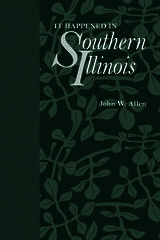 It Happened in Southern Illinois
John W. Allen
Southern Illinois University Press, 1968 In this collection of articles describing the people, places, and folkways of southern Illinois, John W. Allen provides entertaining and informative glimpses into the region’s past. Included here are sketches of the early pioneering days when wolves were literally chased from the door, stories about the many Indian artifacts discovered among the rolling hills and valleys of the area, and articles pertaining to the strategic role the region played during the Civil War. Allen also describes the activities of such infamous outlaws as Samuel Mason and the Harpe brothers as well as the famous Illinois-born heroes “Bat” Masterson, “Wild Bill” Hickok, and Wyatt Earp. In his warm and friendly style, Allen reminisces about the self-sufficient and satisfying rural life of a previous generation with its oxcarts, pie suppers, threshing machines, kerosene lamps, and blacksmith shops. Any reader interested in southern Illinois and its history will delight in this collection of stories from John W. Allen’s popular newspaper column, “It Happened in Southern Illinois.”
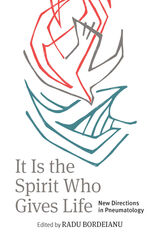 It is the Spirit Who Gives Life: New Directions in Pneumatology
Radu Bordeianu
Catholic University of America Press, 2022 Who is the Holy Spirit? What is the Holy Spirit? The answers to these questions were so obvious in the first centuries of Christian history, that the New Testament and the earliest Christian writers did not feel the need to deliberately address the identity of the Spirit. The more stringent question was this: what does the Spirit do in the Hebrew Scriptures, in the life of Jesus, in the community of disciples, in the Church, and in the world? These same questions, however, did not have the same obvious answers to subsequent generations.
Writing in the fourth century, Gregory of Nazianzus observed a slow progress of better understanding the identity and mission of the Holy Spirit throughout the centuries; his opponents still referred to the Spirit as a “strange,” “unscriptural,” and “interpolated” God (Or. 31). One would expect that today, centuries later, pneumatology would be exponentially further developed than in the patristic era. And yet, contemporary theology only rarely asks who the Spirit is and what the Spirit does. That is where the present volume attempts to bring a contribution, by addressing early Pneumatologies reflected in the Scriptures and the age of the martyrs, historical developments in patristic literature and spiritual writings, and contemporary pneumatological themes, as they relate to ecumenism, ecology, science, ecclesiology, and missions.
The present volume gathers essays authored by eleven world-renowned theologians. Each contribution originated as a public lecture addressed to theologians and an educated general audience, followed by a private colloquium in which the lecturers conferred with scholars who are experts in the field. Thus, the present volume offers a multifaceted approach to Pneumatology, in an ecumenical spirit.
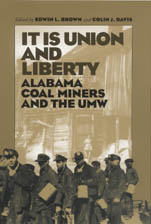 It is Union and Liberty: Alabama Coal Miners, 1898-1998
Edwin L. Brown
University of Alabama Press, 1999 One union, many voices—Alabama coal miners and the century-long fight for justice. Much of Alabama's labor history is written in its coal fields. This book records the critical contribution that District 20 of the United Mine Workers of America played in the state's labor movement through its strong stands on such issues as child labor, public education, and inter-racial unions. Standing at the cutting edge of social and political history, these essays cover five periods over a century of union activity:the emergence of a militant labor force during mining's formative years; the World War I era, when mine operators tried to divide black and white labor; the increasing role of the state in labor relations during the interwar years; rapid changes in the union between 1942 and 1975; and the 1977-79 strike, the largest in the United Mine Workers' history. Through historic photographs and depictions of living and working conditions, contributors Edwin L. Brown, Colin J. Davis, Daniel Letwin, Brian M. Kelly, Peter Alexander, Glenn Feldman, and Robert H. Woodrum portray the world that miners, both black and white, made. In a state where racial segregation was the norm,even the earliest District 20 contract proposals demanded equal pay for equal work regardless of color. It Is Union and Liberty shows that the UMW in Alabama stands apart from perceptions of southern trade unionism
as exclusionary and racially fragmented. It sheds light on an important segment of the state's labor history and is a testament to District 20 on its centennial celebration.
It Isn’t a Ghost if It Lives in Your Chest
Joan Houlihan
Four Way Books, 2021 Houlihan’s sixth collection of lyric poems reflects upon the persistence of what is lost and the accidental ruptures of trauma that allow re-entry into our world. These poems are at once despairing and hopeful.
 It Never Goes Away: Gender Transition at a Mature Age
Anne L. Koch, D.M.D.
Rutgers University Press, 2019 If you are transgendered, the feeling of wanting your body to match the sex you feel you are never goes away. For some, though, especially those who grew up before trans people were widely out and advocating for equality, these feelings were often compartmentalized and rarely acted upon. Now that gender reassignment has become much more commonplace, many of these people may feel increasing pressure to finally undergo the procedures they have always secretly wanted.
Ken Koch was one of those people. Married twice, a veteran, and a world traveler, a health scare when he was sixty-three prompted him to acknowledge the feelings that had plagued him since he was a small child. By undergoing a host of procedures, he radically changed his appearance and became Anne Koch. In the process though, Anne lost everything that Ken had accomplished. She had to remake herself from the ground up. Hoping to help other people in her age bracket who may be considering transitioning, Anne describes the step by step procedures that she underwent, and shares the cost to her personal life, in order to show seniors that although it is never too late to become the person you always knew you were, it is better to go into that new life prepared for some serious challenges. Both a fascinating memoir of a well-educated man growing up trans yet repressed in the mid-twentieth century, and a guidebook to navigating the tricky waters of gender reassignment as a senior, It Never Goes Away shows how what we see in the television world of Transparent translates in real life.
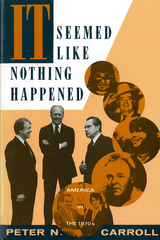 It Seemed Like Nothing Happened: America in the 1970s
Peter N. Carroll
Rutgers University Press, 1990 "A compelling and persuasive challenge to the journalistic characterization of the '70s as the 'Me Decade.'" -- Ruth Rosen, University of California, Davis
"This is the single best book on the 1970s." -- Leo Ribuffo, George Washington University
In this unique, comprehensive history of the 1970s, we learn about international developments: the war in Cambodia, Nixon's trip to China, the oil embargo and resulting gas shortage, the Mayaquez incident, the Camp David accords, the Iranian capture of the U.S. embassy and the taking of hostages, the ill-fated rescue mission. All this signaled a decline in American power and influence. We also learn about domestic politics: Kent State, the Pentagon Papers, Haynsworth and Carswell, the Eagleton affair, the rise of ticket splitting, inflation, recession, unemployment, Watergate, Agnew's resignation, the Saturday night massacre, Nixon's resignation, the pardon for draft evaders, Proposition 13, the politicization of organized religion, the conservative shift in the Democratic Party, and the Reagan electoral landslide. Carroll reminds us of tragedies and occasional moments of levity, bringing up the names Patricia Hearst, George Jackson and Angela Davis, Wilbur Mills and the Argentina Firecracker, Wayne Hays and Elizabeth Ray, Harvey Milk and Mayor George Moscone.
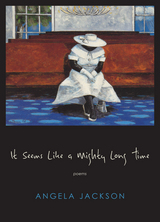 It Seems Like a Mighty Long Time: Poems
Angela Jackson
Northwestern University Press, 2015 2015 PEN Open Book Award Finalist
Angela Jackson’s latest collection of poetry borrows its title from a lyric in Barbara Lewis’s 1963 hit single “Hello Stranger,” recorded at Chess Records in Chicago. Like the song, Jackson’s poems are a melodic ode to the African American experience, informed by both individual lives and community history, from the arrival of the first African slave in Virginia in 1619 to post-Obama America. It Seems Like a Mighty Long Time reflects the maturity of Jackson’s poetic vision. The Great Migration, the American South, and Chicago all serve as signposts, but it is the complexity of individual lives—both her own and those who have gone before, walk beside, and come after—that invigorate this collection. Upon surveying so vast a landscape, Jackson finds that sorrow meets delight, and joy lifts up anger and despair. And for all this time, love is the agent, the wise and just rule and guide.
 It Shouldn't Be This Way: The Failure of Long-Term Care
Robert L. Kane
Vanderbilt University Press, 2005 The failure of long-term care is the country's best-kept embarrassing secret. Almost every adult in the United States will either enter a nursing home or have to deal with a parent or other relative who does. Studies show that 40 percent of all adults who live to age sixty-five will enter a nursing home before they die, while even more will use another form of long-term care.
Part memoir, part practical guide, part prescription for change, It Shouldn't Be This Way is a unique look at the problems of long-term care. Robert L. Kane, a highly experienced physician and gerontologist, and his sister, Joan C. West, tell the painful story of what happened to their mother after she suffered a debilitating stroke and spent the last years of her life in rehabilitation, assisted-living facilities, and finally a nursing home. Along the way, her adult children encountered some professionals who were kind and considerate but also many frustrations—inadequate care and the need to hire private duty aides, as well as poor communication and lack of coordination throughout the system. The situation, they found, proved far more difficult than it needed to be.
As the authors recount their mother's story, they impart various lessons they learned from each phase of the experience. They alert those who are confronting such situations for the first time about what they will likely face and how to approach the problems. Closing with a broader look at why long-term care is the way it is, they propose steps to make necessary reforms, including the development of national organizations to work for change. Their message to families, care professionals, and policy-makers could not be more urgent.
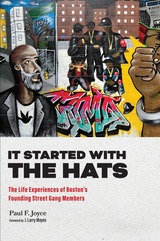 It Started with the Hats: The Life Experiences of Boston’s Founding Street Gang Members
Paul F. Joyce, with a foreword by J. Larry Mayes
Southern Illinois University Press, 2024 In the late 1980s, the introduction of crack cocaine and easy access to guns led to the emergence of the street gang culture and an explosion of gun violence in Boston. Black and Latino youth were both perpetrators and victims of firearm violence as the city grappled with a staggering number of shootings and homicides. Officers within the Boston Police Department struggled to find new and creative ways to combat the growing violence and neutralize gang influence. Paul Joyce was one of those officers.
Throughout his extensive career with the Boston Police, Joyce was at the forefront of the Department’s anti-gang and youth violence initiatives, including during the height of gang and gun violence in the late 1980s through early 1990s. Later in his career, after thirty-one years in policing, Joyce transitioned to academia as a criminologist, seeking to better understand the lives of the gang members he had encountered during his time as an officer. He interviewed thirty Black and Latino men who witnessed and led the emergence of the street gang phenomenon in Boston. Joyce’s strong relationship with community leaders led to the recruitment of the men, who ultimately entrusted him with their life stories and their inner worlds. Using the men’s own words to describe the tragedies they endured, the crimes they committed, and the penalties they paid, Joyce now shares their stories of life before, during, and after gang membership.
Joyce examines the influences that motivated the men toward joining gangs, their gang experiences, and the turning points that shaped their paths later in life, whether leading to desistance from or continued persistence in criminal behavior. Joyce explores their lives from childhood into adulthood, providing a deep analysis of the factors that influenced the entire trajectory of gang members’ lives. By utilizing this life-course approach, Joyce adds to the discourse regarding what influences a gang member’s ability or inability to transition out of criminality and the gang life.
This uniquely candid look at gang membership, humanized by the perspectives of the men who experienced it, provides invaluable insight into the complex interplay of the social, cultural, and personal factors that shape individuals’ life courses. This, in turn, has important implications regarding the types of outside interventions that would be the most effective in making a positive difference in the lives of current and former gang members.
 It Starts with Trouble: William Goyen and the Life of Writing
By Clark Davis
University of Texas Press, 2015 William Goyen was a writer of startling originality and deep artistic commitment whose work attracted an international audience and the praise of such luminaries as Northrop Frye, Truman Capote, Gaston Bachelard, and Joyce Carol Oates. His subject was the land and language of his native East Texas; his desire, to preserve the narrative music through which he came to know his world. Goyen sought to transform the cherished details of his lost boyhood landscape into lasting, mythic forms. Cut off from his native soil and considering himself an “orphan,” Goyen brought modernist alienation and experimentation to Texas materials. The result was a body of work both sophisticated and handmade—and a voice at once inimitable and unmistakable. It Starts with Trouble is the first complete account of Goyen’s life and work. It uncovers the sources of his personal and artistic development, from his early years in Trinity, Texas, through his adolescence and college experience in Houston; his Navy service during World War II; and the subsequent growth of his writing career, which saw the publication of five novels, including The House of Breath, nonfiction works such as A Book of Jesus, several short story collections and plays, and a book of poetry. It explores Goyen’s relationships with such legendary figures as Frieda Lawrence, Katherine Anne Porter, Stephen Spender, Anaïs Nin, and Carson McCullers. No other twentieth-century writer attempted so intimate a connection with his readers, and no other writer of his era worked so passionately to recover the spiritual in an age of disabling irony. Goyen’s life and work are a testament to the redemptive power of storytelling and the absolute necessity of narrative art.
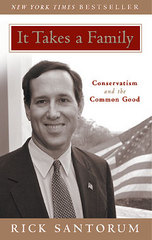 It Takes a Family: Conservatism and the Common Good
Rick Santorum
Intercollegiate Studies Institute, 2006
Among politicians of national stature today, there is perhaps none more respected as a principled conservative than Rick Santorum. In It Takes a Family: Conservatism and the Common Good, Santorum articulates the humane vision that he believes must inform public policy if it is to be effective and just. An appreciation for the civic bonds that unite a community lies at the heart of genuine conservatism. Moreover, Santorum demonstrates how such an approach to political, social, and economic problems offers the most promise for those on the margin of life: the poor, the vulnerable, and minorities who have often been excluded from opportunity in America.
Santorum argues that conservative statesmanship is animated by a sense of stewardship for an inheritance. But what do we inherit as Americans? And how can we be good stewards of that inheritance? Building on Robert Putnam’s discussion of “social capital,” the habits of association and trust that are the preconditions of any decent society, Santorum assesses how well, in the past generation, Americans have cared for the “fabric” of society. He explores in detail various dimensions of social and cultural connection that are the foundation of the common good. And he presents innovative policy proposals for the renewal of American society at all levels.
Throughout his book, Santorum emphasizes the central role of the family—in contradistinction to the metaphorical “village” of the federal government, as promoted by Hillary Clinton—in achieving the common good. With a sustained argument touching on first principles throughout, this ambitious and original book is a major contribution to contemporary political debate. It Takes a Family further establishes Santorum as the leader of reform-minded civic conservatives in America.
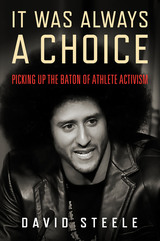 It Was Always a Choice: Picking Up the Baton of Athlete Activism
David Steele
Temple University Press, 2022 The recent flashpoint of Colin Kaepernick taking a knee renews a long tradition of athlete-activists speaking out against racism, injustice, and oppression. Like Kaepernick, Jackie Robinson, Paul Robeson, Muhammad Ali, Bill Russell, Tommie Smith, and John Carlos—among many others, of all races, male and female, pro and amateur—all made the choice to take a side to command public awareness and attention rather than “shut up and play,” as O. J. Simpson, Michael Jordan, and Tiger Woods did. Using their celebrity to demand change, these activists inspired fans but faced great personal and professional risks in doing so. It Was Always a Choice traces the history and impact of these decisive moments throughout the history of U.S. sports. David Steele identifies the resonances and antecedents throughout the twentieth century of the choices faced by athletes in the post-Kaepernick era, including the advance of athletes’ political organizing in the era of activism following the death of George Floyd. He shows which athletes chose silence instead of action—“dropping the baton,” as it were—in the movement to end racial inequities and violence against Black Americans. The examples of courageous athletes multiply as LeBron James, Megan Rapinoe and the activist-athletes of the NBA, WNBA, and NFL remain committed to fighting daily and vibrantly for social change.
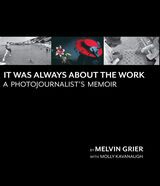 It Was Always About the Work: A Photojournalist's Memoir
Melvin Grier
Ohio University Press, 2023 Award-winning photojournalist Melvin Grier discusses the influences and circumstances that led him to tell stories through the camera.
Over the last six decades, Melvin Grier’s work has vividly portrayed community, humanity, irony, fear, war, elegance, art, and, most notably, the unexpected. It Was Always About the Work includes nearly one hundred black-and-white and color photographs, including photographs from Grier’s most famous exhibitions and news stories. Whether covering local events, Cincinnati life, impoverished villages overseas, young future Marines on their way to their first post, or high fashion, Grier's photos are unmistakable and evocative.
Starting with his early years as a boy growing up in Cincinnati, this book tells the story of a young man who won his first photo contest while in the Air Force. He came home determined to make a career as a photographer, and, despite his lack of formal training and experience, he secured a job as a photographer for the Cincinnati Post. After the closure of the Cincinnati Post in 2007, Grier continued his career as an independent artist, featuring work in exhibitions such as “White People: A Retrospective” and “Clothes Encounters.” In collaboration with one of his journalist partners, reporter Molly Kavanaugh, Grier shares why it was always about the work.
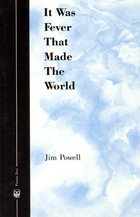 It Was Fever That Made The World
Jim Powell
University of Chicago Press, 1989 This sophisticated first collection by Jim Powell synthesizes personal and world history to produce a compelling vision of the past, through verse letters to friends and relatives, translations of Horace, Propertius, Sappho, and others, and allusions to ancient figures of history and mythology.
"I find it difficult to overpraise the ease of this writing, which in one act combines succinct physical presentation and explanation of it. . . . It is perhaps here that Jim Powell, not yet forty, most shows his superiority to many of his contemporaries and seniors. He not only understands the way in which opposites are necessary to one another, he achieves his knowledge in the poem, and so we grasp it as we read. . . . he has tapped a subject matter that is endless and important, and by the thoroughgoingness and the subtlety of his exploration shows he has the power to do almost anything."—Thom Gunn, Shelf Life
"His title burns away everywhere in the volume, in the fevers of eros, divination, memory, destruction, and grief. . . . Page for page, there is more sheer fine, clear, yet syntactically subtle and metaphorically gorgeous writing in Powell than I have seen in some time."—Mary Kinzie, Poetry
"Jim Powell's poems, like those of Thomas Hardy, are haunted forms, full of ghosts and mocking gods, shadows and foreshadowings. But Powell is a Hardy whose poems we've never read, a Hardy with his hand in the blaze, not stirring the ash in a cold and wind-torn grate."—Jennifer Clarvoe, The Threepenny Review
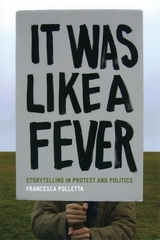 It Was Like a Fever: Storytelling in Protest and Politics
Francesca Polletta
University of Chicago Press, 2006 Activists and politicians have long recognized the power of a good story to move people to action. In early 1960 four black college students sat down at a whites-only lunch counter in Greensboro, North Carolina, and refused to leave. Within a month sit-ins spread to thirty cities in seven states. Student participants told stories of impulsive, spontaneous action—this despite all the planning that had gone into the sit-ins. “It was like a fever,” they said.
Francesca Polletta’s It Was Like a Fever sets out to account for the power of storytelling in mobilizing political and social movements. Drawing on cases ranging from sixteenth-century tax revolts to contemporary debates about the future of the World Trade Center site, Polletta argues that stories are politically effective not when they have clear moral messages, but when they have complex, often ambiguous ones. The openness of stories to interpretation has allowed disadvantaged groups, in particular, to gain a hearing for new needs and to forge surprising political alliances. But popular beliefs in America about storytelling as a genre have also hurt those challenging the status quo.
A rich analysis of storytelling in courtrooms, newsrooms, public forums, and the United States Congress, It Was Like a Fever offers provocative new insights into the dynamics of culture and contention.
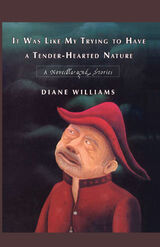 It Was Like My Trying to Have a Tender-Hearted Nature: A Novella and Stories
Diane Williams
University of Alabama Press, 2007 This work by Diane Williams delves into the strange relationships of men and women. From marital betrayal to spousal abuse and unrelenting desire, Williams illuminates the lives of her characters in prose as sparse and stark as it is beautiful. These stories are as short as prose poems and as complex as novels. In them, meanings remain ambiguous and consequences seem uncertain. In the novella “On Sexual Strength” she describes the intense and sometimes strange relationship between two neighboring couples and the rage that comes with adultery, and a narrator whose social inadequacies and lack of inhibitions lead to destruction. The world Williams creates is a sensual place where quiet epiphanies—such as the one that occurs after an extramarital affair— are also possible: “It was like My Trying to Have a Tender-Hearted nature. This is how love can be featured.” Such flashes of insight and emotion glue together the fragments of life Williams lays before the reader, and the reader rejoices at the revelations.
"It Was Play or Starve": Acting in the Nineteenth-Century American Popular Theatre
John Hanners
University of Wisconsin Press, 1993 American popular entertainers in the nineteenth century faced physical hardships, prejudices, and cultural barriers. This book examines the fascinating world of these itinerant actors and their experiences with early showboats, frontier theater, minstrelsy, panorama exhibitions, and the circus. Admirable and not-so-admirable characters, who possessed equal amounts of pluck, courage, and naiveté, are contrasted popular cultural tastes
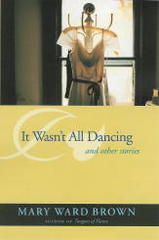 It Wasn't All Dancing and Other Stories
Mary Ward Brown
University of Alabama Press, 2001 This eagerly anticipated second volume of short stories is offered by nationally acclaimed writer Mary Ward Brown, often referred to as the “first lady” of Alabama letters With the 11 stories in this long-awaited collection, Mary Ward Brown once again offers her devoted fans a palette of new literary pleasures. The hallmarks of her style, so finely wrought in the award-winning Tongues of Flame (1986)—the fully realized characters, her deep sensitivity, a defining sense of place and time—are back in all their richness to involve and enchant the reader. All but one of the stories are set in Alabama. They deal with dramatic turning points in the lives of characters who happen to be southerners, many jaxtaposed between Old South sensibility and manners and New South modernity and expectations. Among these is a new widow who is not consoled by well-meaning, proselytizing Christians; a middle-aged waitress in love with the town “catch”; a bedridden belle dependent upon her black nurse; a “special” young man in a newspaper shop; a young faculty wife who attempts generosity with a lower-class neighbor; and a lawyer caught in the dilemma of race issues. Through their diverse voices, Brown proves herself a graceful and gifted storyteller who writes with an authoritative pen, inventing and inhabiting the worlds of her set of characters with insight, compassion, and wit. Most of the stories in It Wasn't All Dancing have appeared previously in prominent national magazines and literary journals, including the Atlantic Monthly, Grand Street, and Threepenny Review. This fine collection should appeal to a wide audience among writers, literature scholars, and general readers alike.
It Will Be All Right in the Morning: Poems
Michael Burns
University of Arkansas Press, 1998 In his plain-spoken lyrics and dramatic monologues, Michael Burns digs at the marrow. His poems—in formal and free verse—are quick, incisive, and always capable of revealing the dark whimsies of fate and the pain of our own actions and inactions. These poems travel to Casqui mounds in the Arkansas Delta, traffic-clogged urban streets, a wasteland in Oklahoma, and Faulkner’s Rowan Oak. They assume the voices of others so convincingly that we find ourselves face to face with hunters, philanderers, husbands, a Union general, a Snopes, and even a version of God. Gathering the images of each place, crafting lines in clear, unpretentious language, Burns comes across new knowledge, confronting the ever-present mysteries and the ways the mind loves to lie to itself.
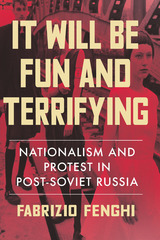 It Will Be Fun and Terrifying: Nationalism and Protest in Post-Soviet Russia
Fabrizio Fenghi
University of Wisconsin Press, 2021 The National Bolshevik Party, founded in the mid-1990s by Eduard Limonov and Aleksandr Dugin, began as an attempt to combine radically different ideologies. In the years that followed, Limonov, Dugin, and the movements they led underwent dramatic shifts. The two leaders eventually became political adversaries, with Dugin and his organizations strongly supporting Putin’s regime while Limonov and his groups became part of the liberal opposition.
To illuminate the role of these right-wing ideas in contemporary Russian society, Fabrizio Fenghi examines the public pronouncements and aesthetics of this influential movement. He analyzes a diverse range of media, including novels, art exhibitions, performances, seminars, punk rock concerts, and even protest actions. His interviews with key figures reveal an attempt to create an alternative intellectual class, or a “counter-intelligensia.” This volume shows how certain forms of art can transform into political action through the creation of new languages, institutions, and modes of collective participation.
It Will Return: Poems
Julia Hartwig
Northwestern University Press, 2010 In It Will Return, her most recent volume of poems, Julia Hartwig is in dialogue with other great artists—Keats, Rimbaud, Milosz, Beethoven, Ravel, Van Gogh—considering the implications of greatness. Alongside this expansive perspective, we find attention to the smallest details, composing quotidian moments that open out into unexpected meaning. For Hartwig, close attention to the material world is a kind of spiritual undertaking. Like her Nobel Prize–winning contemporary Wislawa Szymborska, she writes poems that appear simple but are somehow all the more capable of yielding profound insights. It Will Return reflects Hartwig’s firsthand involvement in Polish history and culture, and its poems are sensitive to the calamities of Poland’s tumultuous twentieth century. But It Will Return is a human collection before it is a national one, and these political motifs form the backdrop for more universal dramas.
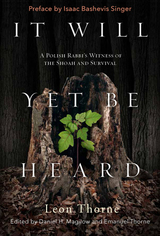 It Will Yet Be Heard: A Polish Rabbi's Witness of the Shoah and Survival
Isaac Bashevis Singer
Rutgers University Press, 2019 Nobel laureate Isaac Bashevis Singer once described Dr. Leon Thorne’s memoir as a work of “bitter truth” that he compared favorably to the works of Tolstoy, Dostoevsky, and Proust. Out of print for over forty years, this lost classic of Holocaust literature now reappears in a revised, annotated edition, including both Thorne’s original 1961 memoir Out of the Ashes: The Story of a Survivor and his previously unpublished accounts of his arduous postwar experiences in Germany and Poland.
Rabbi Thorne composed his memoir under extraordinary conditions, confined to a small underground bunker below a Polish peasant’s pigsty. But, It Will Yet Be Heard is remarkable not only for the story of its composition, but also for its moral clarity and complexity. A deeply religious man, Rabbi Thorne bore witness to forced labor camps, human degradation, and the murders of entire communities. And once he emerged from hiding, he grappled not only with survivor’s guilt, but also with the lingering antisemitism and anti-Jewish violence in Poland even after the war ended. Harrowing, moving, and deeply insightful, Rabbi Thorne’s firsthand account offers a rediscovered perspective on the twentieth century’s greatest tragedy.
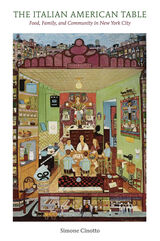 The Italian American Table: Food, Family, and Community in New York City
Simone Cinotto
University of Illinois Press, 2013 Best Food Book of 2014 by The Atlantic
Looking at the historic Italian American community of East Harlem in the 1920s and 30s, Simone Cinotto recreates the bustling world of Italian life in New York City and demonstrates how food was at the center of the lives of immigrants and their children. From generational conflicts resolved around the family table to a vibrant food-based economy of ethnic producers, importers, and restaurateurs, food was essential to the creation of an Italian American identity. Italian American foods offered not only sustenance but also powerful narratives of community and difference, tradition and innovation as immigrants made their way through a city divided by class conflict, ethnic hostility, and racialized inequalities. Drawing on a vast array of resources including fascinating, rarely explored primary documents and fresh approaches in the study of consumer culture, Cinotto argues that Italian immigrants created a distinctive culture of food as a symbolic response to the needs of immigrant life, from the struggle for personal and group identity to the pursuit of social and economic power. Adding a transnational dimension to the study of Italian American foodways, Cinotto recasts Italian American food culture as an American "invention" resonant with traces of tradition.
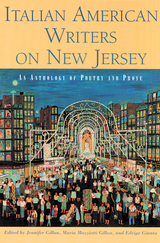 Italian American Writers on New Jersey: An Anthology of Poetry and Prose
Edited by Jennifer Gillan, Maria Mazziotti Gillan, and Edvige Giunta
Rutgers University Press, 2003 This anthology gathers fiction, poetry, memoirs, oral histories, and journalistic pieces by some of the best writers to chronicle the Italian American experience in the Garden State. These works focus on ethnic identity and the distinctive culture of New Jersey, which has long been home to a large and vital Italian American community. Filled with passion, humor, and grace, these writings depict a variety of experiences, including poignant but failed attempts at conformity and the alienation often felt by ethnic Americans. The authors also speak of the strength gained through the preservation of their communities and the realization that it is often the appreciation of their heritage that helps them to succeed. Although presented from the vantage point of only one ethnic group, this book addresses in microcosm the complexities of American identity, depicting situations and conveying emotions that will resonate with people of all immigrant ancestries. Among the many writers featured are Gay Talese, Bill Ervolino, Tom Perrotta, Louise DeSalvo, Carole Mazo, Diane di Prima, and Maria Laurino. Each of the contributors provides a fresh perspective on the diversity, complexity, and richness of the Italian American experience. Publication of this book is made possible in part by a grant from the Institute of Italian and Italian American Heritage Studies, State of New Jersey.
Italian and Spanish Art 1600-1750: Sources and Documents
Robert Enggass
Northwestern University Press, 1993 The Baroque period was crucial for the development of art theory and the advancement of the artistic academy. This collection of primary sources brings this important period to life with significant documents and texts. It conveniently assembles major texts, which are otherwise available only in scattered publications. The lives of leading artists--Caravaggio, El Greco, among others---are discussed by their contemporaries, while Bellori, Galileo, Pascoli, and others write on art theory and practice. The documents provide fascinating glimpses of the period's artistic self-image.
Italian Art 1400-1500: Sources and Documents
Creighton Gilbert
Northwestern University Press, 1980 Creighton E. Gilbert captures the spirit of the early Renaissance in this remarkable collection of primary texts by and about artists of the fifteenth century. Italian Art makes a valuable contribution not only to the field of art history, but also to social and intellectual history. Almost all aspects of the life of the period—war, fashion, travel, communication—are documented. Revealing significant aspects of the practice of art, the process of patronage, and the way of life and social position of early Renaissance artists, Italian Art brings this fascinating period to life for students and scholars.
Italian Art 1500–1600: Sources and Documents
Robert Klein and Henri Zerner
Northwestern University Press, 1966 Italian Art, 1500–1600 provides a unique view of the development of the literature on art in Italy during the Cinquecento. The selections bring out the close relationship between art theories and the actuality of art and chart a trend from a humanistic orientation to a more technical and professorial one. The documents and commentary reveal the effects that humanistic circles, the courts, and the Church—during the Renaissance and the Counter-Reformation—had on the way people wrote and thought about art.
Italian Blood: A Memoir
Denise Tolan
CavanKerry Press, 2023 A memoir dealing with the aftermath of abuse.
“I’ve heard that some volcanic eruptions are soft with oozing streams of lava dancing down the side of the volcano like a Las Vegas chorus line. My father’s eruptions were quick, like bricks being thrown through a window.”
Denise Tolan’s memoir-in-essay traces the legacy of violence in an Italian American family, showing how abuse reverberates both in the body and mind of a family. The book’s first part, “Blood is Not Water,” lays out how the origins of violence can infect the roots of a family tree. The second part, “Good Blood Doesn’t Lie,” shows what grows from those roots. Italian Blood is a raw, heartbreaking series of essays where everything is connected through literal and metaphorical blood. These essays offer a connection to anyone who suffered childhood shame, violence, or fear and provide reassurance that they are not alone.
 Italian Chronicles
Stendhal
University of Minnesota Press, 2017 Nineteenth-century French writer Marie-Henri Beyle, better known by his pen name Stendhal, is one of the earliest leading practitioners of realism, his stories filled with sharp analyses of his characters’ psychology. This translation of Stendhal’s Chroniques italiennes is a collection of nine tales written between 1829 and 1840, many of which were published only after his death. Together these collected tales reveal a great novelist working with highly dramatic subject matter to forge a vision of life lived at its most intense. The setting for these tales is a romanticized Italy, a place Stendhal viewed as unpolluted by bourgeois inhibitions and conformism. From the hothouse atmosphere of aristocratic convents to the horrors of the Cenci family, the tales in Italian Chronicles all feature passionate, transgressive characters engaged in “la chasse au bonheur”—the quest for happiness. Most of the tragic, violent tales are based on historical events, with Stendhal using history to validate his characters’ extreme behaviors as they battle literal and figurative oppression and try to break through to freedom. Complete with revenge, bloody daggers, poisonings, and thick-walled nunneries, this new translation of Italian Chronicles includes four never-before-translated stories and a fascinating introduction detailing the origins of the book. It is sure to gratify established Stendhal fans as well as readers new to the writer.
Italian Courts and European Culture
Marcello Fantoni
Amsterdam University Press, 2022 Between the fifteenth and the eighteenth century, princely courts dominated the Italian political scene. These courts were effervescent centers of cultural production. As such, they became a model for European monarchies who imported Italian courtly forma del vivere (‘style of life’) to legitimize their power and to define social status. This phenomenon included architecture and painting, theater and music, manners and aesthetics, and all the objects, behaviors and beliefs that contributed to homogenize European culture in the age of the Old Regime. It involved a hemorrhage of art and a continuous circulation of people, texts and symbols. The foundational material for this process was classicism and its purpose was political. This delineates a new geography and chronology of a truly European cultural history. It also provides the key traits for the European cultural identity.
 The Italian Fascist Party in Power: A Study in Totalitarian Rule
Dante L. Germino
University of Minnesota Press, 1959 The Italian Fascist Party in Power was first published in 1959. Minnesota Archive Editions uses digital technology to make long-unavailable books once again accessible, and are published unaltered from the original University of Minnesota Press editions. Although much significant material on the Italian Fascist party became available when the regime collapsed, scholars have not made extensive use of it until now. In this study, which is based on all the available sources, Professor Germino describes the functions of the party, ,explains how it was organized to perform tasks, and discusses conflicts between the party and other power elements in the dictatorship. He reaches a conclusion contrary to that of most other scholars -- that Fascist Italy was a full-fledged totalitarian state resembling Nazi Germany and Soviet Russia in political structure and ideological content. Professor Carl J. Riedrich of Harvard University writes: "I consider this a major contribution to our knowledge of totalitarian dictatorship. There is nothing in the existing literature that can be compared to it either in terms of depth or analysis, range of documentation or breadth of treatment." Professor Taylor Cole of Duke University comments: "Professor Germino has presented an excellent case study of the Italian Fascist Party. He has made use of more materials on the Party than any previous writer in English, and has marshalled them effectively to support his contention that the Fascist Party did not differ 'in kind' from [the Nazi and Soviet Communist parties] on the eve of World War II. His conclusion that on most (though not all) basic counts the Italian Fascist system was to be classified as 'totalitarian' is controversial, but it merits the careful attention of all students who are interested in the Italian Fascist period and in totalitarianism."
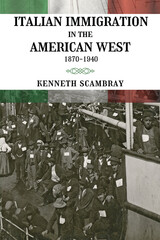 Italian Immigration in the American West: 1870-1940
Kenneth Scambray
University of Nevada Press, 2021 In this carefully researched and engaging book, Kenneth Scambray surveys the lives and contributions of Italian immigrants in thirteen western states. He covers a variety of topics, including the role of the Roman Catholic Church in attracting and facilitating Italian settlement; the economic, political, and cultural contributions made by Italians; and the efforts to preserve Italian culture and to restore connections to their ancestral identity.
The lives of immigrants in the West differed greatly from those of their counterparts on the East Coast in many ways. The development of the West—with its cheap land and mining, forestry, and agriculture industries\--created a demand for labor that enabled newcomers to achieve stability and success. Moreover, female immigrants had many more opportunities to contribute materially to their family’s well-being, either by overseeing new revenue streams for their farms and small businesses, or as paid workers outside the home.
Despite this success, Italian immigrants in the West could not escape the era’s xenophobia. Scambray also discusses the ways that Italians, perceived by many as non-White, interacted with other Euro-Americans, other immigrant groups, and Native Americans and African Americans.
By placing the Italian immigrant experience within the context of other immigrant narratives, Italian Immigration in the American West provides rich insights into the lives and contributions of individuals and families who sought to build new lives in the West. This unique study reveals the impact of Italian immigration and the immense diversity of the immigrant experience outside the East’s urban centers.
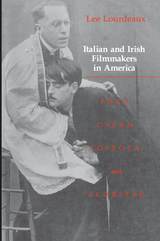 Italian Irish Filmmakers
Lee Lourdeaux
Temple University Press, 1993 "This penetrating study examines how these filmmakers confronted their cultural heritage and used it as a counterpoint to their depiction of mainstream America."
--American Cinematographer
In this unique film history, Lee Lourdeaux traces the impact of Irish and Italian cultures on four major American directors and their work. Defining the core values and tensions within each culture, and especially focusing on the influence of American Catholicism, he presents John Ford, Frank Capra, Francis Coppola, and Martin Scorsese as ethnic Americans and film artists. Lourdeaux shows each filmmaker on set with writers and actors, learning to bypass stereotypes in order to develop a shrewd reciprocal assimilation between his ethnic background and Anglo America.
Beginning with D. W. Griffith's depiction of Irish and Italian immigrants, the author discusses Hollywood's stereotypical portrayals of ethnic priests, cops, politicians, and gangsters, as well as their surface acculturation in the movies of the 1920s. By the decade's end, John Ford was using all-American stories to embody the basic myths and tensions of Irish-American life. In his later westerns and foreign films, he tried to understand both Irish political strife and the key figures of Irish liturgy. Frank Capra pitted Italian family values against the Anglo success ethic, turning out social comedies about oppressed little people. Several decades later, Martin Scorsese and Francis Coppola were highly critical of their religio-ethnic heritage, though they gradually discovered that to outline its weaknesses, like the blind pursuit of success, was to fashion a critical mirror of mainstream America. Lourdeaux discusses a number of recent films by Coppola and by Scorsese that have not yet been analyzed in any book. And, in the chapter on Scorsese, a personal interview with the director reveals how his ethnic childhood shaped his work in film.
Examining the conflicts within American culture, Lourdeaux shows how the filmmakers themselves had to confront the self-destructive aspects of their ethnic background, not only to accommodate WASP audiences but to better understand their own heritage. He also observes that ethnicity is a strong draw at the box office, as in The Godfather, because it creates a sense of the Other who can both be admired and at the same time ridiculed. Illustrated with scenes of the movies discussed, this fascinating film history tells how four of America's most famous filmmakers assimilated their ethnic backgrounds on set and on screen.
"Mr. Lourdeaux walks a tricky path in analyzing the films of each [director]: avoiding the trap of excessively detailing their lives and many films, while steering clear of ethnic stereotyping. Those interested in ethnic influences on outstanding persons or in the production of films by four of the best will find the book enjoyable."
--The Baltimore Sun
"This is an invaluable book because it arouses critical awareness of the ethnicity underlying many Hollywood movies that might otherwise appear merely to represent American archetypes."
--Journal of American Studies
"A valuable addition to the literature on ethnic identity in film. The insights Lourdeaux offers into major figures like Griffith, Ford, Capra, Coppola, and Scorsese contribute significantly to our understanding of their films."
--Virginia Wright Wexman, University of Illinois at Chicago
"For a number of years now, church historians have been giving us an account of American Catholicism that is much richer and more varied than the older institutional accounts of the Catholic Church ever let on. In this comprehensive and insightful study, Lee Lourdeaux shows us how much the ethnic movies of directors like Ford and Capra, Coppola and Scorsese have to teach us as well about Irish- and Italian-Catholic mores and instincts."
--John B. Breslin, S.J., Director
"A wonderfully sensitive, intelligent study of the complex issue of how the Catholic imagination works in the creative personalities of those raised in the Catholic heritage."
--Andrew M. Greeley
An Italian Journey
Jean Giono
Northwestern University Press, 1998 In An Italian Journey, Jean Giono describes his journey to the land of his father's people. A reluctant traveler (he rarely left Provence), Giono discovers a strange beauty not only in the palazzi and canals of Venice but also in wistful waiters, suspicious hairdressers, pugnacious men of God, recalcitrant coffeemakers, umbrellas, and field machinery. In Giono's world a stamp collectors' market can appear to verge on revolution and inept municipal musicians suddenly offer Mozartian joys.
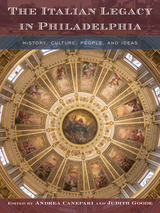 The Italian Legacy in Philadelphia: History, Culture, People, and Ideas
Edited by Andrea Canepari and Judith Goode
Temple University Press, 2021 Italian arts and culture have been a significant influence on Philadelphia dating back to Thomas Jefferson and colonial times. Throughout the ensuing decades, Italian art and architecture styles flourished, and wealthy Philadelphians traveled to Italy and brought back objects to display in emerging institutions of art and culture. New immigration formed neighborhoods—such as South Philly, home to the Italian Market—and Italian business leaders, politicians, artists, musicians and sports figures came to prominence and became part of the social fabric of the city. This glorious volume, The Italian Legacy in Philadelphia, celebrates the history, impact, and legacy of this vibrant community, tracing four periods of key transformation in the city’s political, economic, and social structures. The editors and contributors chronicle the changing dynamics of the city as Italian immigrants established themselves and as they continue to have lively interactions with people and institutions in Italy. Interdisciplinary essays, along with nearly 250 gorgeous images, explore the changing perspectives and styles of those who contributed Italian influences. As settlers and their descendants brought everyday cultural practices, memories, and traditions, they created different Italian-American experiences that became important parts of American culture, a legacy that is thriving in contemporary, globalized Philadelphia.
 Italian Locations: Reinhabiting the Past in Postwar Cinema
Noa Steimatsky
University of Minnesota Press, 2008 Fascism and the Second World War left Italy indelibly changed, and cinema was arguably the art that most rigorously confronted the devastated nation. In this examination of four Italian filmmakers, Noa Steimatsky brilliantly maps their forceful negotiation of Italy’s identity and posits that the cinematic forms they employ constitute an imaginary reinhabiting of Italy-one that is inextricably linked with the political, physical, and symbolic predicament of reconstruction. A dynamic intersection of pictorial and photographic, architectural and literary discourses inform Steimatsky’s revisionist interrogation of exemplary works from the 1940s to the mid–1960s. From the earliest documentary work of Michelangelo Antonioni on the River Po to Pier Paolo Pasolini’s re-siting of the Gospel in the arid, peripheral landscape of the Italian south, and from Roberto Rossellini’s tracing of a neorealist project in ruinous Berlin to Luchino Visconti’s wrought grandeur visited upon a humble Sicilian fishing village, Italian Locations probes the historical experience of displacement, anachronism, and a thoroughly contemporary anxiety in the cinematic arena. For Steimatsky, Antonioni’s modernist achievement, informed by his native landscape, Rossellini’s neorealist image of Italy as a nation of ruins, Visconti’s reaching back to the nineteenth century and even more archaic pasts, and Pasolini’s ambivalence about modernity-all partake in a search for a politically and culturally redeemed Italy. Noa Steimatsky is associate professor of the history of art and film studies at Yale University.
The Italian Opera Singers in Mozart's Vienna
Dorothea Link
University of Illinois Press, 2022 Dorothea Link examines singers’ voices and casting practices in late eighteenth-century Italian opera as exemplified in Vienna’s court opera from 1783 to 1791. The investigation into the singers’ voices proceeds on two levels: understanding the performers in terms of the vocal-dramatic categories employed in opera at the time; and creating vocal profiles for the principal singers from the music composed expressly for them. In addition, Link contextualizes the singers within the company in order to expose the court opera's casting practices. Authoritative and insightful, The Italian Opera Singers in Mozart's Vienna offers a singular look at a musical milieu and a key to addressing the performance-practice problem of how to cast the Mozart roles today.
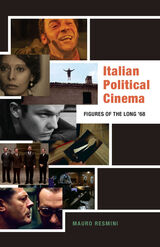 Italian Political Cinema: Figures of the Long ’68
Mauro Resmini
University of Minnesota Press, 2022 An exploration of how film has made legible the Italian long ’68 as a moment of crisis and transition Traditionally, the definition of political cinema assumes a relationship between cinema and politics. In contrast to this view, author Mauro Resmini sees this relationship as an impasse. To illustrate this theory, Resmini turns to Italian cinema to explore how films have reinvented the link between popular art and radical politics in Italy from 1968 to the early 1980s, a period of intense political and cultural struggles also known as the long ’68. Italian Political Cinema conjures a multifaceted, complex portrayal of Italian society. Centered on emblematic figures in Italian cinema, it maps the currents of antagonism and repression that defined this period in the country’s history. Resmini explores how film imagined the possibilities, obstacles, and pitfalls that characterized the Italian long ’68 as a moment of crisis and transition. From workerism to autonomist Marxism to feminism, this book further expands the debate on political cinema with a critical interpretation of influential texts, some of which are currently only available in Italian. A comprehensive and novel redefinition of political film, Italian Political Cinema introduces its audience to lesser-known directors alongside greats such as Pasolini, Bertolucci, Antonioni, and Bellocchio. Resmini offers access to untranslated work in Italian philosophy, political theory, and film theory, and forcefully advocates for the continued artistic and political relevance of these films in our time.
Italian Public Enterprise
M. V. Posner and S. J. Woolf
Harvard University Press This study surveys the role of state enterprise in Italy over the last fifteen years. Focusing on the history and recent growth of the public sector there, the authors examine the structure, performance, and control of some typical state enterprises, the methods of finance, and the pattern of investment.
Their pioneering work, although it formulates no easy answers about the ideal role of public enterprise, marshals a great many useful facts and arguments concerning the one outstanding national experiment in this direction to date.
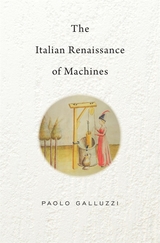 The Italian Renaissance of Machines
Paolo Galluzzi
Harvard University Press, 2019 The Renaissance was not just a rebirth of the mind. It was also a new dawn for the machine.
When we celebrate the achievements of the Renaissance, we instinctively refer, above all, to its artistic and literary masterpieces. During the fifteenth and sixteenth centuries, however, the Italian peninsula was the stage of a no-less-impressive revival of technical knowledge and practice. In this rich and lavishly illustrated volume, Paolo Galluzzi guides readers through a singularly inventive period, capturing the fusion of artistry and engineering that spurred some of the Renaissance’s greatest technological breakthroughs.
Galluzzi traces the emergence of a new and important historical figure: the artist-engineer. In the medieval world, innovators remained anonymous. By the height of the fifteenth century, artist-engineers like Leonardo da Vinci were sought after by powerful patrons, generously remunerated, and exhibited in royal and noble courts. In an age that witnessed continuous wars, the robust expansion of trade and industry, and intense urbanization, these practitioners—with their multiple skills refined in the laboratory that was the Renaissance workshop—became catalysts for change. Renaissance masters were not only astoundingly creative but also championed a new concept of learning, characterized by observation, technical know-how, growing mathematical competence, and prowess at the draftsman’s table.
The Italian Renaissance of Machines enriches our appreciation for Taccola, Giovanni Fontana, and other masters of the quattrocento and reveals how da Vinci’s ambitious achievements paved the way for Galileo’s revolutionary mathematical science of mechanics.
The Italian Resistance: Fascists, Guerrillas and the Allies
Tom Behan
Pluto Press, 2009 One of the enduring myths about World War Two is that only the Allies liberated occupied Europe. Many countries had anti-fascist Resistance movements, and Italy's was one of the biggest and most politically radical yet it remains relatively unknown outside of its own homeland.
Within Italy many plaques and streets commemorate the actions of the partisans - a movement from below that grew as Mussolini's dictatorship unravelled. Led by radical left forces, the Resistance trod a thin line between fighting their enemies at home and maintaining an uneasy working relationship with the Allies.
Essential for courses on World War Two and European history, Tom Behan uses unpublished archival material and interviews with surviving partisans to tell an inspiring story of liberation.
Italian Sculpture of the Renaissance
Eric Maclagan
Harvard University Press Italian sculpture of the Renaissance has long suffered in comparison with the admiration enjoyed by Italian painting of the same period. Such depreciation is, in Dr. Maclagan’s opinion, eminently unjust; and with the equipment of a well-grounded student of the Renaissance, he devotes the present work to placing the sculpture in its proper light. He touches briefly in the beginning upon the sculpture of the great revival of art and letters in the eleventh and twelfth centuries, and then considers in greater detail the splendor of achievement between the fifteenth and seventeenth centuries. Although his approach is necessarily an historical one, he subordinates his framework to his larger purpose. The Charles Eliot Norton Lectures for 1927-1928.
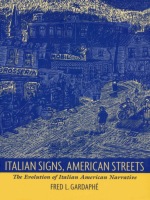 Italian Signs, American Streets: The Evolution of Italian American Narrative
Fred L. Gardaphé
Duke University Press, 1996 In the first major critical reading of Italian American narrative literature in two decades, Fred L. Gardaphé presents an interpretive overview of Italian American literary history. Examining works from the turn of the twentieth century to the present, he develops a new perspective—variously historical, philosophical, and cultural—by which American writers of Italian descent can be read, increasing the discursive power of an ethnic literature that has received too little serious critical attention.
Gardaphé draws on Vico’s concept of history, as well as the work of Gramsci, to establish a culture-specific approach to reading Italian American literature. He begins his historical reading with narratives informed by oral traditions, primarily autobiography and autobiographical fiction written by immigrants. From these earliest social–realist narratives, Gardaphé traces the evolution of this literature through tales of “the godfather” and the mafia; the “reinvention of ethnicity” in works by Helen Barolini, Tina DeRosa, and Carole Maso; the move beyond ethnicity in fiction by Don DeLillo and Gilbert Sorrentino; to the short fiction of Mary Caponegro, which points to a new direction in Italian American writing.
The result is both an ethnography of Italian American narrative and a model for reading the signs that mark the “self-fashioning” inherent in literary and cultural production. Italian Signs, American Streets promises to become a landmark in the understanding of literature and culture produced by Italian Americans. It will be of interest not only to students, critics, and scholars of this ethnic experience, but also to those concerned with American literature in general and the place of immigrant and ethnic literatures within that wide framework.
Italian TV Drama and Beyond: Stories from the Soil, Stories from the Sea
Milly Buonanno
Intellect Books, 2012 Since its inception in the mid-1950s, the television drama has emerged as the dominant medium of contemporary storytelling in Italian society, with a steadily increasing supply of locally produced domestic dramas offering up competing versions of Italian identity. Informed by the nation’s rich historical and cultural heritage—as well as a string of notable foreign imports—the narratives discussed here offer much insight into Italian society and highlight the wide array of television programming available outside of Britain and the United States.
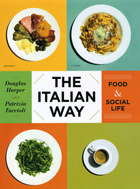 The Italian Way: Food and Social Life
Douglas Harper and Patrizia Faccioli
University of Chicago Press, 2009 Outside of Italy, the country’s culture and its food appear to be essentially synonymous. And indeed, as The Italian Way makes clear, preparing, cooking, and eating food play a central role in the daily activities of Italians from all walks of life. In this beautifully illustrated book, Douglas Harper and Patrizia Faccioli present a fascinating and colorful look at the Italian table. The Italian Way focuses on two dozen families in the city of Bologna, elegantly weaving together Harper’s outsider perspective with Faccioli’s intimate knowledge of the local customs. The authors interview and observe these families as they go shopping for ingredients, cook together, and argue over who has to wash the dishes. Throughout, the authors elucidate the guiding principle of the Italian table—a delicate balance between the structure of tradition and the joy of improvisation. With its bite-sized history of food in Italy, including the five-hundred-year-old story of the country’s cookbooks, and Harper’s mouth-watering photographs, The Italian Way is a rich repast—insightful, informative, and inviting.
Italian Women's Theatre, 1930-1960: An Anthology of Plays
Translations and Critical Introductions by Daniela Cavallaro
Intellect Books, 2011 Between 1930 and 1960, popular female dramatists, including Paola Riccora, Anna Bonacci, Clotilde Masci, and Gici Ganzini Granata, set the stage for a new generation of feminist theatre and the development of contemporary Italian women’s theatre as a whole. Now largely forgotten, the lives and works of these dramatists are reintroduced into the scholarly conversation in Italian Women’s Theatre, 1930–1960. Following a general introduction, the book presents a selection of dramatic works, rounded out by commentary, performance histories, critical analyses, and biographical information.
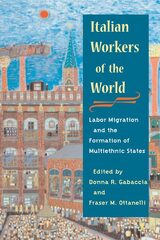 Italian Workers of the World: Labor Migration and the Formation of Multiethnic States
Edited by Donna R. Gabaccia and Fraser M. Ottanelli
University of Illinois Press, 2001 In Italian Workers of the World, a distinguished roster of contributors examines how the reception of immigrants in their new countries shaped their sense of national identity and shaped the multiethnic states where they settled. Argentina and Brazil welcomed Italian migrants as a civilizing influence, and these immigrant workers played an instrumental part in establishing and leading movements committed to labor internationalism. In the United States, by contrast, the American Federation of Labor's hostility to socialism, internationalism, and unskilled laborers fueled distrust and xenophobia that steered Italian immigrants into ethnically mixed unions like radical Industrial Workers of the World. Essays also focus on specific topics ranging from the work of republican Garibaldians in South America to antifascist currents among Italian migrants in France and the United States, and from a 1912 textile strike in Lawrence, Massachusetts, to Mussolini's invasion of Ethiopia. Contributors: Antonio Bechelloni, Fernando J. Devoto, Pietro Rinaldo Fanesi, Donna R. Gabaccia, Mirta Zaida Lobato, Fraser M. Ottanelli, Carina Frid de Silberstein, Michael Miller Topp, Angelo Trento, Nadia Venturini, and Elisabetta Vezzosi
Italians in Michigan
Russell M. Magnaghi
Michigan State University Press, 2001 For more than 350 years, Italian immigrants have played important roles in the opening and development of the land that is now Michigan, from their participation in the French fur trade up to the present day. Through an emphasis on the family as the essential institution in ethnic group success, Russell M. Magnaghi celebrates the accomplishments of Michigan's famous and not-so-famous Italian sons and daughters as he documents their struggles and achievements. Through the tenacity and hard work of the immigrants and their descendants, Italians in Michigan have progressed from unskilled laborers to some of the highest positions in business, politics, culture, and education.
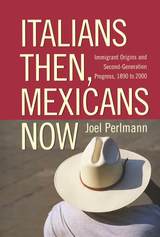 Italians Then, Mexicans Now: Immigrant Origins and the Second-Generation Progress, 1890-2000
Joel Perlmann
Russell Sage Foundation, 2005 According to the American dream, hard work and a good education can lift people from poverty to success in the "land of opportunity." The unskilled immigrants who came to the United States from southern, central, and eastern Europe in the late 19th and early 20th centuries largely realized that vision. Within a few generations, their descendants rose to the middle class and beyond. But can today's unskilled immigrant arrivals—especially Mexicans, the nation's most numerous immigrant group—expect to achieve the same for their descendants? Social scientists disagree on this question, basing their arguments primarily on how well contemporary arrivals are faring. In Italians Then, Mexicans Now, Joel Perlmann uses the latest immigration data as well as 100 years of historical census data to compare the progress of unskilled immigrants and their American-born children both then and now. The crucial difference between the immigrant experience a hundred years ago and today is that relatively well-paid jobs were plentiful for workers with little education a hundred years ago, while today's immigrants arrive in an increasingly unequal America. Perlmann finds that while this change over time is real, its impact has not been as strong as many scholars have argued. In particular, these changes have not been great enough to force today's Mexican second generation into an inner-city "underclass." Perlmann emphasizes that high school dropout rates among second-generation Mexicans are alarmingly high, and are likely to have a strong impact on the group's well-being. Yet despite their high dropout rates, Mexican Americans earn at least as much as African Americans, and they fare better on social measures such as unwed childbearing and incarceration, which often lead to economic hardship. Perlmann concludes that inter-generational progress, though likely to be slower than it was for the European immigrants a century ago, is a reality, and could be enhanced if policy interventions are taken to boost high school graduation rates for Mexican children. Rich with historical data, Italians Then, Mexicans Now persuasively argues that today's Mexican immigrants are making slow but steady socio-economic progress and may one day reach parity with earlier immigrant groups who moved up into the heart of the American middle class. Copublished with the Levy Economics Institute of Bard College
 Italy and American Female Imagination
Debra Bernardi
Ohio State University Press, 2025 Italy and American Female Imagination is the first study to trace the significance of Italy—both the physical place and imagined idea—to the identities of middle-class US women from the nineteenth century to the twenty-first. Debra Bernardi takes a transnational and feminist approach to texts by Harriet Beecher Stowe, Mary McCarthy, Andrea Lee, Elizabeth Gilbert, Jhumpa Lahiri, and others, as well as to film, television, magazine articles, and interviews with expats, all to illuminate not only Italy’s influence on American identity but also how gender, race, and class inflect that influence. Encounters with Italy, Bernardi shows, have profoundly shifted American women’s ways of thinking about sex and romance, families and homes, and rules and regulations. While women of color do not experience Italy as an entirely liberatory space, and attitudes toward Italy have shifted over time, the women writers discussed here consistently find expanded possibilities for female selfhood on Italian soil. Bridging feminist literary studies, cultural studies, and history, Italy and American Female Imagination captures and complicates Italy’s allure and casts new light on the process of transnational identity formation.
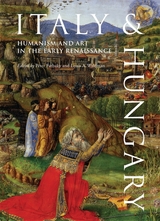 Italy and Hungary: Humanism and Art in the Early Renaissance. Acts of an International Conference, Florence, Villa I Tatti, June 6–8, 2007
Péter Farbaky
Harvard University Press, 2011 In the later fifteenth century, the Kingdom of Hungary became the first land outside Italy to embrace the Renaissance, thanks to its king, Matthias Corvinus, and his humanist advisors, János Vitéz and Janus Pannonius. Matthias created one of the most famous libraries in the Western World, the Bibliotheca Corviniana, rivaled in importance only by the Vatican. The court became home to many Italian humanists, and through his friendship with Lorenzo the Magnificent, Matthias obtained the services of such great Florentine artists as Andrea del Verrocchio, Benedetto da Maiano, and Filippino Lippi. After Matthias’s death in 1490, interest in Renaissance art was continued by his widowed Neapolitan queen, Beatrice of Aragon, and by his successors Vladislav I and Louis II Jagiello.
The twenty-two essays collected in this volume provide a window onto recent research on the development of humanism and art in the Hungary of Matthias Corvinus and his successors. Richly illustrated with new photography, this book eloquently documents and explores the unique role played by the Hungarian court in the cultural history of Renaissance Europe.
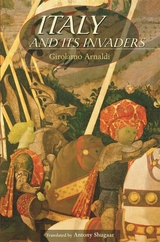 Italy and Its Invaders
Girolamo Arnaldi
Harvard University Press, 2005 From the earliest times, successive waves of foreign invaders have left their mark on Italy. Beginning with Germanic invasions that undermined the Roman Empire and culminating with the establishment of the modern nation, Girolamo Arnaldi explores the dynamic exchange between outsider and “native,” liberally illustrated with interpretations of the foreigners drawn from a range of sources. A despairing Saint Jerome wrote, of the Sack of Rome by the Visigoths in 410, “My sobs stop me from dictating these words. Behold, the city that conquered the world has been conquered in its turn.” Other Christian authors, however, concluded that the sinning Romans had drawn the wrath of God upon them.
Arnaldi traces the rise of Christianity, which in the transition from Roman to barbarian rule would provide a social bond that endured through centuries of foreign domination. Incursions cemented the separation between north and south: the Frankish conquerors held sway north of Rome, while the Normans settled in the south. In the ninth century, Sicily entered the orbit of the Muslim world when Arab and Berber forces invaded. During the Renaissance, flourishing cities were ravaged by foreign armies—first the French, who during the siege of Naples introduced an epidemic of syphilis, then the Spanish, whose control preserved the country’s religious unity during the Counter-Reformation but also ensured that Italy would lag behind during the Enlightenment.
Accessible and entertaining, this outside-in history of Italy is a telling reminder of the many interwoven strands that make up the fabric of modern Europe.
Italy at the Polls, 1983: A Study of the National Elections
Howard R. Penniman, ed.
Duke University Press, 1987 In this book of the At the Polls series, Duke University Press has joined with the American Enterprise Institute for Public Policy Research to publish studies on the electoral process as it functions around the world. Cited by Choice for it's "high standards of scholarly analysis and objectivity", At the Polls provides both a chronicle of events and a thorough analysis of the elections results.
Italy Illuminated
Biondo Flavio
Harvard University Press, 2016 Biondo Flavio (1392–1463), humanist and historian, was a pioneering figure in the Renaissance discovery of antiquity; famously, he was the author who popularized the term “Middle Age” to describe the period between the fall of the Roman Empire and the revival of antiquity in his own time. While serving a number of Renaissance popes, he inaugurated an extraordinary program of research into the history, cultural life, and physical remains of the ancient world.
Italy Illuminated (1453), of which this is the second and final volume, is a topographical work describing Italy region by region. Its aim is to explore the Roman roots of modern Italy. As such, it is the quintessential work of Renaissance antiquarianism.
Italy Illuminated
Biondo FlavioEdited and translated by Jeffrey A. White
Harvard University Press, 2005 Biondo Flavio (1392-1463), humanist and historian, was a pioneering figure in the Renaissance recovery of classical antiquity. While serving a number of the Renaissance popes, he inaugurated an extraordinary program of research into the history, institutions, cultural life, and physical remains of the ancient Roman empire. The Italia Illustrata (1453), which appears here for the first time in English, is a topographical work describing Italy region by region. Its aim is to explore the Roman roots of the Renaissance world. As such, it is the quintessential work of Renaissance antiquarianism. This is the first edition of the Latin text since 1559.
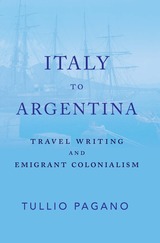 Italy to Argentina: Travel Writing and Emigrant Colonialism
Tullio Pagano
Amherst College Press, 2023 In Italy to Argentina: Travel Writing and Emigrant Colonialism, Tullio Pagano examines Italian emigration to Argentina and the Rio de la Plata region through the writings of Italian economists, poets, anthropologists, and political activists from the 1860s to the beginning of World War I. He shows that Italians played an important role in the so-called conquest of the desert, which led to Argentina's economic expansion and the suppression and killing of the remaining indigenous population. Many of the texts he discusses have hardly been studied before: from Paolo Mantegazza’s real and imaginary travel narratives at the time of Italian unification to Gina Lombroso’s descriptions of Brazil, Uruguay, and Argentina in early 1900s. Pagano questions the apparent opposition between diaspora and empire and argues that there was a continuity between the “peaceful conquest” though spontaneous emigration envisioned by Italian liberal intellectuals at the turn of the century and the military colonialism of Italian Nationalists and Fascists. He shows that racist assumptions about Native American and “creole” cultures were present in the work of progressive authors like Edmondo de Amicis, whose writings became enormously popular in Argentina, and anarchist militants and legal scholars like Pietro Gori, who founded the first revolutionary unions in Buenos Aires while remaining dangerously attached to Cesare Lombroso’s theories of atavism and primitivism. The “growl” of Italian emigrants about to land in Argentina, found in Dino Campana’s poem Buenos Aires (1907), echoes throughout Pagano’s book, and encourages the reader to explore the apparent oxymoron of “emigration colonialism” and the role of literature and public media in the formation of our social imaginary.
“Italy to Argentina shows meticulous bibliographic work and is attentive to both fundamental and marginal texts in a double task, on the one hand, of textual analysis, and on the other, of rescuing and recovering a corpus forgotten by critics even when it is highly significant. It is, then, a research work that addresses the Italian emigration to Argentina from an original point of view, linking texts that have not been studied or that have not been sufficiently analyzed.” —Fernanda Elisa Bravo Herrera, author of Huellas y recorridos de una utopía: La emigración italiana en la Argentina
"From Boccadasse to La Boca. Tullio Pagano complexifies the relationship between ‘diaspora’ and ‘colonialism’ in the context of Italian migration to South America. In six thematic chapters, Pagano explores the thought of authors on and off the canon. Such diverse voices lead the reader to a new approach to the study of emigrant colonialism and creole studies, towards a deeper, more realistic understanding of the ‘conquest of the desert’ that Italian emigrants wanted to perform in Argentina."—Giuseppe Gazzola, Stony Brook University
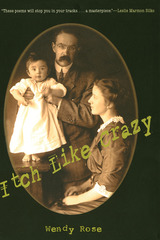 Itch Like Crazy
Wendy Rose
University of Arizona Press, 2002 Among Native American writers of mixed-blood heritage, few have expressed their concerns with personal identity with as much passion as Wendy Rose. A mainstay among American Indian poets whose work addresses these issues, she is a writer with whom readers of diverse ethnic backgrounds have consistently identified.
In her latest work, Rose returns to these major motifs while exploring a new dimension: using poetry as a tool to delve into the buried secrets of family history—and all of American history as well. Confronting questions of personal history that itch like crazy—the irritations that drive human existence—she acknowledges and pays tribute to her Indian and European ancestors without hiding her anger with American society.
Rose's poems are strong political and social statements that have a distinctly narrative flavor. Here are Europeans who first set foot on America's shores while Taino Indians greeted them as if they were visiting neighbors; Hopi and Miwok "Clan Mothers, grand-daughters, all those the missionaries erased"; and European forebears who as settlers pushed their way relentlessly west. Through her vivid imagery, she speaks to and for these ancestors with a sense of loss and an itching caused by the biases provoked by ethnic chauvinism.
Itch Like Crazy is a finely crafted literary work that is also a manifesto addressing contacts and conflicts in the history of Indian-white relations. By presenting another view of U.S. history and its impact on the Native Americans who are her ancestors, it offers a new appreciation of the issue of "tribal identity" that too often faces Native peoples of the Americas—and is too often misunderstood by Euro-American society.
Itérations
Hans-Jörg Rheinberger
Diaphanes, 2013 Sous ce titre qui rend hommage à la pensée de Derrida, sont rassemblées des conférences tenues par le biologiste Hans-Jörg Rheinberger entre 1994 et 2007. Six textes aussi brefs que denses, nourris de vie de laboratoire et de philosophie franco-allemande – de Gaston Bachelard à Bruno Latour en passant par Martin Heidegger et Jacques Lacan –, qui donnent à voir un mouvement épistémologique sur le temps long. Tentant de faire dialoguer cet héritage philosophique avec la biologie moléculaire contemporaine, Itérations propose des variations sur l'inconnu et l'insoupçonné dans la recherche scientifique, et sur les systèmes expérimentaux comme contextes déterminants de la production des savoirs – cernant toujours les manifestations de l'Être comme écriture.
Excellente introduction à cette pensée de l'épistémologie historique, Itérations est l’un des prolongements les plus féconds de la pensée de Derrida.
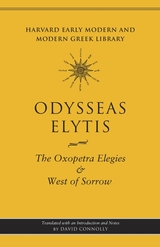 The Oxopetra Elegies and West of Sorrow
Odysseas Elytis
Harvard University Press, 2012 This volume contains translations of two late collections by Odysseas Elytis (Nobel Prize for literature, 1979). According to the official announcement of the Swedish Academy, the Nobel Prize was awarded to Elytis “for his poetry, which, against the background of Greek tradition, depicts with sensuous strength and intellectual clear-sightedness modern man's struggle for freedom and creativeness.” The Oxopetra Elegies, which he published in November 1991 at the age of eighty, was immediately hailed as one of his finest works. Far from being a dialogue with death, as many critics hastily concluded, these elegies are laments for what is seen and perceived in certain “timeless moments” that, like the Oxopetra headland, project into the beyond, into another reality, revealing truths that, to the poet’s constant dismay, remain “unverifiable” and “unutterable.” The poems here function as a “contemporary form of magic,” a key opening the portals to this other reality, at least for those who speak Elytis’ language: the language of the Secret Sun. In West of Sorrow, published in November 1995, only months before his death, it becomes even clearer that his poetry remains, as it always was, a paean to life and love and beauty.
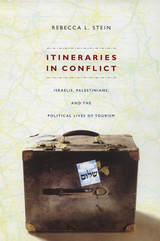 Itineraries in Conflict: Israelis, Palestinians, and the Political Lives of Tourism
Rebecca L. Stein
Duke University Press, 2008 In Itineraries in Conflict, Rebecca L. Stein argues that through tourist practices—acts of cultural consumption, routes and imaginary voyages to neighboring Arab countries, culinary desires—Israeli citizens are negotiating Israel’s changing place in the contemporary Middle East. Drawing on ethnographic and archival research conducted throughout the last decade, Stein analyzes the divergent meanings that Jewish and Palestinian citizens of Israel have attached to tourist cultures, and she considers their resonance with histories of travel in Israel, its Occupied Territories, and pre-1948 Palestine. Stein argues that tourism’s cultural performances, spaces, souvenirs, and maps have provided Israelis in varying social locations with a set of malleable tools to contend with the political changes of the last decade: the rise and fall of a Middle East Peace Process (the Oslo Process), globalization and neoliberal reform, and a second Palestinian uprising in 2000. Combining vivid ethnographic detail, postcolonial theory, and readings of Israeli and Palestinian popular texts, Stein considers a broad range of Israeli leisure cultures of the Oslo period with a focus on the Jewish desires for Arab things, landscapes, and people that regional diplomacy catalyzed. Moving beyond conventional accounts, she situates tourism within a broader field of “discrepant mobility,” foregrounding the relationship between histories of mobility and immobility, leisure and exile, consumption and militarism. She contends that the study of Israeli tourism must open into broader interrogations of the Israeli occupation, the history of Palestinian dispossession, and Israel’s future in the Arab Middle East. Itineraries in Conflict is both a cultural history of the Oslo process and a call to fellow scholars to rethink the contours of the Arab-Israeli conflict by considering the politics of popular culture in everyday Israeli and Palestinian lives.
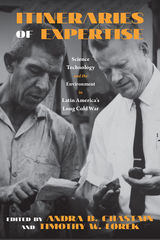 Itineraries of Expertise: Science, Technology, and the Environment in Latin America's Long Cold War
Andra Chastain and Timothy Lorek
University of Pittsburgh Press, 2020 Itineraries of Expertise contends that experts and expertise played fundamental roles in the Latin American Cold War. While traditional Cold War histories of the region have examined diplomatic, intelligence, and military operations and more recent studies have probed the cultural dimensions of the conflict, the experts who constitute the focus of this volume escaped these categories. Although they often portrayed themselves as removed from politics, their work contributed to the key geopolitical agendas of the day. The paths traveled by the experts in this volume not only traversed Latin America and connected Latin America to the Global North, they also stretch traditional chronologies of the Latin American Cold War to show how local experts in the early twentieth century laid the foundation for post–World War II development projects, and how Cold War knowledge of science, technology, and the environment continues to impact our world today. These essays unite environmental history and the history of science and technology to argue for the importance of expertise in the Latin American Cold War.
 Itineraries of Power: Texts and Traversals in Heian and Medieval Japan
Terry Kawashima
Harvard University Press, 2016 Movements—of people and groups, through travel, migration, exile, and diaspora—are central to understanding both local and global power relationships. But what of more literary moves: textual techniques such as distinct patterns of narrative flow, abrupt leaps between genres, and poetic figures that flatten geographical distance? This book examines what happens when both types of tropes—literal traversals and literary shifts—coexist.
Itineraries of Power examines prose narratives and poetry of the mid-Heian to medieval eras (900–1400) that conspicuously feature tropes of movement. Kawashima argues that the appearance of a character’s physical motion, alongside literary techniques identified with motion, is a textual signpost in a story, urging readers to focus on how the work conceptualizes relations of power and claims to authority. From the gendered intersection of register shifts in narrative and physical displacement in the Heian period, to a dizzying tale of travel retold multiple times in a single medieval text, the motion in these works gestures toward internal conflicts and alternatives to existing structures of power. The book concludes that texts crucially concerned with such tropes of movement suggest that power is always simultaneously manufactured and dismantled from within.
 The Itineraries of William Wey
Translated and Edited by Francis Davey
Bodleian Library Publishing, 2010
In 1456 and again in 1458, William Wey (1405/6–76) set out on journeys across a Europe in turmoil from local conflicts and cross-border expansions. Wey, a Devon priest and bursar of Eton College, had been granted special dispensation by Henry VI to undertake pilgrimages, and he was prompted by his friends to write an account of his itinerant adventures. He collected his stories from his travels to the Cathedral of Santiago de Compostela in Spain and later Jerusalem in the fifteen chapters that comprise The Itineraries.
The Itineraries contains practical travel advice for the period on conduct and currency, alongside comparative English, Latin, Greek and Hebrew vocabularies, in addition to a remarkable scrapbook compendium of places, roads, and distances. Originally written in English and Latin, Wey’s fascinating observations of a changing Europe are for for first time available in a modern English edition. The pilgrimage was an idea essential to medieval and early modern Christianity, and Wey’s work adds a new dimension to our understanding of its importance and practice. Wey is at once adventurous and highly observant, and The Itineraries will be of interest to scholars of early modern history and armchair pilgrims alike.
 Tria sunt: An Art of Poetry and Prose
Martin Camargo
Harvard University Press, 2019 The Tria sunt, named for its opening words, was a widely used and highly ambitious book composed in England in the late fourteenth century during a revival of interest in the art of poetry and prose.
The backbone of this comprehensive guide to writing Latin texts is the wealth of illustrative and instructive sources compiled, including examples from classical authors such as Cicero and Horace as well as from medieval literature, and excerpts from other treatises of the same period by authors from Matthew of Vendôme through Gervase of Melkley. Topics treated at length include methods for beginning and ending a composition, techniques for expanding and abbreviating a text, varieties of figurative language, attributes of persons and actions, and the art of letter writing.
This anonymous treatise, related especially closely to work by Geoffrey of Vinsauf, served as a textbook for rhetorical composition at Oxford. Of all the major Latin arts of poetry and prose, it is the only one not previously edited or translated into English.
It's a Living: Work and Life in Vietnam Today
Edited by Gerard Sasges
National University of Singapore Press, 2013 Through 67 interviews and 59 photographs, It’s a Living reveals the energy and struggle of the world of work in Vietnam today. A goldfish peddler installing aquariums, a business school graduate selling shoes on the sidewalk, a college student running an extensive multi-level sales network, and a promotion girl intent on moving into management are just a few of the people profiled.
Based on frank and freewheeling interviews conducted by students, the book engages a broad range of Vietnamese, both living in Vietnam and abroad, on their feelings about work, life and getting ahead. By providing a ground-level view of the texture of daily working life in the midst of rapid and unsettling change, the book reveals Vietnam today as a place where ordinary people are leveraging whatever assets they have, not just to survive, but to make a better life for themselves.
 It’s a Matter of Survival
Anita Gordon and David Suzuki
Harvard University Press, 1991 “The greenhouse effect is us, and it is specifically us in the Western world.” This is one of the messages at the beginning of Anita Gordon and David Suzuki’s startling view of our future on Earth. More than any other time in history, the 1990s have marked a turning point for human civilization. Not only are we facing ecological disasters that will affect our ability to survive, but the crisis is forcing us to reexamine the entire value system that has governed our lives for the past two thousand years.
Gordon and Suzuki warn us of the transition we will need to make if we are to arrive safely in the next century. More than a book on the environment, this is a book about us as a species: our shortsightedness, our failure to read the warnings, our inability to grasp the significance of our actions-and the tough decisions we have to make in order to save ourselves.
The power of the book lies in the consensus of the many voices, those of scientists and other scholars, that speak through it. The components of our predicament—global warming, soil erosion, acid rain, species depletion, ozone damage, rainforest destruction, overpopulation—are quantified with authority. And never before has such a strong consensus been expressed in a single warning. The message we receive is that our actions are taking place in a political and economic world that demands radical change.
In an effort to counteract this blueprint for disaster, Gordon and Suzuki present a resounding rebuttal of technological optimism and the belief that continued economic growth is a prerequisite for environmental reform. The intellectual fog of sustainable development is incisively dispelled, and in its place the authors suggest practical contributions that individuals as well as governments can make toward creating a “conserver society.”
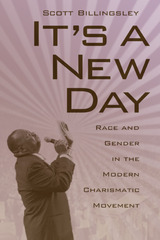 It's a New Day: Race and Gender in the Modern Charismatic Movement
Scott Billingsley
University of Alabama Press, 2008 It’s a New Day chronicles the rise of women and African American evangelists in the independent charismatic movement in post-World War II America. Billingsley observes current figures such as T. D. Jakes, Joyce Meyer, and Creflo Dollar, who were deeply influenced by charismatic pioneers Oral Roberts and Kenneth Hagin. The evangelists adopted their ministry-building and prosperity gospel tactics and are notable for megachurches, televangelism, and health-and-wealth doctrines. The modern charismatic movement has grown far more sophisticated and has become a truly international phenomenon, and Pentecostals and charismatics hold a wide variety of views on race and gender. Charismatic women ministers take to the pulpit, manage publishing empires, and lead the faithful in modern America. Similarly, both black and white charismatic ministers preach to integrated churches and hold integrated revivals, even while racial divides endure in the larger society. It’s a New Day contributes to our understanding and appreciation of one of the most vital sectors in current American religious life.
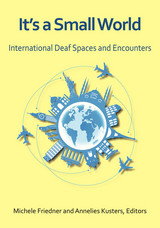 It's a Small World: International Deaf Spaces and Encounters
Michele Friedner
Gallaudet University Press, 2015 It’s a Small World explores the fascinating and, at times, controversial concept of DEAF-SAME (“I am deaf, you are deaf, and so we are the same”) and its influence on deaf spaces locally and globally. The editors and contributors focus on national and international encounters (e.g., conferences, sporting events, arts festivals, camps) and the role of political/economic power structures on deaf lives and the creation of deaf worlds. They also consider important questions about how deaf people negotiate DEAF-SAME and deaf difference, with particular attention to relations between deaf people in the global South (countries in Africa, Asia, and Latin America, with access to fewer resources than other countries) and the global North (countries in Europe, along with Canada, the US, Australia, and several other nations with access to and often control of resources). Editors Michele Friedner and Annelies Kusters and their contributors represent a variety of academic and professional fields, from anthropology and linguistics to cultural and religious studies. Each chapter in this original volume highlights a new perspective on the multiple intersections that occur between nationalities, cultures, languages, religions, races, genders, and identities. The text is organized into five sections—Gatherings, Language, Projects, Networks, and Visions. Taken all together, the 23 chapters in this book provide an understanding of how sameness and difference are powerful yet contested categories in deaf worlds.
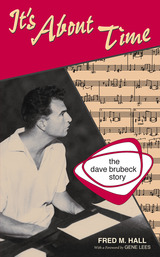 It's About Time: The Dave Brubeck Story
Fred Hall
University of Arkansas Press, 1996 A much-revered icon of jazz, Dave Brubeck is, as Doug Ramsey calls him, “one of the most celebrated and successful jazz musicians of all time.” It’s About Time, Fred Hall’s biography, explores the many influences on Brubeck’s life and music: his youth on a cattle ranch in the foothills of the Sierras; a stint in Europe with Patton’s army during World War II; the development of the West Coast jazz scene and the rise of the Dave Brubeck Quartet; musical relationships with Paul Desmond, Eugene Wright, Joe Morello, and many more jazz greats; his phenomenal experiments with polytonality and polyrhythm; his fifty-three-year marriage to Iola, manager, collaborator, and mother of their six children; and important career breakthroughs, such as the first-ever million-selling jazz single, “Take Five.” Including an annotated discography, It’s About Time is much more than an upbeat examination of the Brubeck phenomenon. It is also a penetrating view of the culture, the music, the musicians, the recording industry, and race relations of the country and the century that gave birth to jazz.
It's Alive!: The Science of B-Movie Monsters
Michael LaBarbera
University of Chicago Press, 2013 The B-movie monster—be it gap-toothed gorilla, ripped-from-time dinosaur, overstretched arachnid, or another outrageous anthropomorphic fantasy—has thrilled moviegoers for decades, and firmly sunk its claws into popular culture. In It’s Alive!, Michael LaBarbera delves into the science behind these characters’ construction, from the biology surrounding tyrannosaurid postures in Jurassic Park and King Kong to the questionable physics employed by The Incredible Shrinking Man. Accompanied by a treasure trove of images from old movie posters and stills, and ranging from the 1930s to such recent films as The Lord of the Rings trilogy and the latest installments of the Alien franchise, It’s Alive! cleverly uses science to remind us that the best parts of moviemaking might indeed be magic–for all creatures, great and small.
 It’s All a Kind of Magic: The Young Ken Kesey
Rick Dodgson
University of Wisconsin Press, 2013 Counterculture icon and best-selling author of the anti-authoritarian novels One Flew Over the Cuckoo’s Nest and Sometimes a Great Notion, Ken Kesey said he was “too young to be a beatnik and too old to be a hippie.” It’s All a Kind of Magic is the first biography of Kesey. It reveals a youthful life of brilliance and eccentricity that encompassed wrestling, writing, farming, magic and ventriloquism, CIA-funded experiments with hallucinatory drugs, and a notable cast of characters that would come to include Wallace Stegner, Larry McMurtry, Tom Wolfe, Neal Cassady, Timothy Leary, the Grateful Dead, and Hunter S. Thompson. Based on meticulous research and many interviews with friends and family, Rick Dodgson’s biography documents Kesey’s early life, from his time growing up in Oregon through his college years, his first drug experiences, and the writing of his most famous books. While a graduate student in creative writing at Stanford University in the late 1950s and early 1960s, Kesey worked the night shift at the Menlo Park Veterans Administration hospital, where he earned extra money taking LSD and other psychedelic drugs for medical studies. Soon he and his bohemian crowd of friends were using the same substances to conduct their own experiments, exploring the frontiers of their minds and testing the boundaries of their society. With the success of One Flew Over the Cuckoo’s Nest, Kesey moved to La Honda, California, in the foothills of San Mateo County, creating a scene that Hunter S. Thompson remembered as the “world capital of madness.” There, Kesey and his growing band of Merry Prankster friends began hosting psychedelic parties and living a “hippie” lifestyle before anyone knew what that meant. Tom Wolfe’s book The Electric Kool-Aid Acid Test mythologized Kesey’s adventures in the 1960s. Illustrated with rarely seen photographs, It’s All a Kind of Magic depicts a precocious young man brimming with self-confidence and ambition who—through talent, instinct, and fearless spectacle—made his life into a performance, a wild magic act that electrified American and world culture.
“Rick Dodgson has pored over Kesey’s published and unpublished writings, interviews, and historical records to write a colorful biography of this charismatic American character. The resulting portrayal challenges assumptions about Kesey’s place in the counterculture.”—Journal of American History
“Dodgson’s painstaking research unearths hidden gems of Kesey’s life that marked him as a fascinating figure.”—H-Net
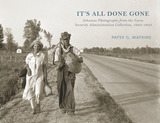 It's All Done Gone: Arkansas Photographs from the Farm Security Administration Collection, 1935-1943
Patsy Watkins
University of Arkansas Press, 2018 In 1935 a fledging government agency embarked on a project to photograph Americans hit hardest by the Great Depression. Over the next eight years, the photographers of the Farm Security Administration captured nearly a quarter-million images of tenant farmers and sharecroppers in the South, migrant workers in California, and laborers in northern industries and urban slums.
Of the roughly one thousand FSA photographs taken in Arkansas, approximately two hundred have been selected for inclusion in this volume. Portraying workers picking cotton for five cents an hour, families evicted from homes for their connection with the Southern Tenant Farmers Union, and the effects of flood and drought that cruelly exacerbated the impact of economic disaster, these remarkable black-and-white images from Ben Shahn, Arthur Rothstein, Dorothea Lange, Walker Evans, Russell Lee, and other acclaimed photographers illustrate the extreme hardships that so many Arkansans endured throughout this era.
These powerful photographs continue to resonate, providing a glimpse of life in Arkansas that will captivate readers as they connect to a shared past.
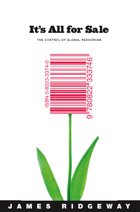 It's All for Sale: The Control of Global Resources
James Ridgeway
Duke University Press, 2004 Five companies dominate the U.S. petroleum industry. Five control the worldwide trade in grain. Two have a corner on the private market for drinking water. In terms of actual dollars, trade in heroin, cocaine, and tobacco ranks alongside that in grain or metals. There are more slaves in the world today than ever before. Resource by resource, It’s All for Sale uncovers and discloses who owns, buys, and sells what. Some resources—such as fuel, metals, fertilizers, drugs, fibers, food, forests, and flowers—have, for better or worse, long been thought of as commodities. Others—including fresh water, human beings, the sky, the oceans, and life itself (in the form of genetic codes)—are more startling to think of as products with price tags, but, as James Ridgeway shows, they are treated as such on a massive scale in lucrative markets around the world.
Revealing the surprisingly small number of companies that control many of the basic commodities we use in everyday life, It’s All for Sale confirms in specific detail that globalization has been accompanied by an extraordinary concentration of ownership. At the same time, it is about much more than what company has cornered the market in corn or diamonds. Corporations and captains of industry, wars and swindles, oppressors and the oppressed, empires and colonies, military might and commercial power, economic boom and bust—all these come alive in Ridgeway’s canny and arresting reporting about the global scramble for power and profit. It’s All for Sale is an invaluable source for researchers, activists, and all those concerned with globalization, corporate power, and the exploitation of individuals and the environment.
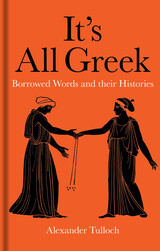 It’s All Greek: Borrowed Words and their Histories
Alexander Tulloch
Bodleian Library Publishing, 2018 Most of us are aware that the words for some of our most important concepts stem from ancient Greek roots—words such as geometry, democracy, technology, and aesthetics. But lesser known is the wide and varied scope of old Athenian influence on the English language, which extends to some of our most mundane, run-of-the-mill words—words like purse, sketch, and marmalade.
This book offers a word-by-word look at the influence of Greek on everyday words in English, telling the stories behind the etymological developments of each example and tracing their routes into modern English via Latin and European languages. It also explains connections with ancient Greek culture, in particular mythology, politics, and warfare, and includes proverbs and quotations from Greek literature. Revealing how deeply indebted we are to the language spoken in Athens 2,500 years ago, this book is the perfect gift for any logophile.
 It's All in the Delivery: Pregnancy in American Film and Television Comedy
Victoria Sturtevant
University of Texas Press, 2024 2025 John G. Cawelti Award for the Best Textbook/Primer, Popular Culture Association/American Culture Association (PCA/ACA)
2025 Longlist, Kraszna-Krausz Moving Image Book Award How changing depictions of pregnancy in comedy from the start of the twentieth century to the present show an evolution in attitudes toward women’s reproductive roles and rights. Some of the most groundbreaking moments in American film and TV comedy have centered on pregnancy, from Lucille Ball’s real-life pregnancy on I Love Lucy, to the abortion plot on Maude; Murphy Brown’s controversial single motherhood; Arnold Schwarzenegger’s pregnancy in Junior; or the third-trimester stand-up special Ali Wong: Baby Cobra. In the first book-length study of pregnancy in popular comedy, Victoria Sturtevant examines the slow evolution of pregnancy tropes during the years of the Production Code; the sexual revolution and changing norms around nonmarital pregnancy in the 1960s and ‘70s; and the emphasis on biological clocks, infertility, adoption, and abortion from the 1980s to now. Across this history, popular media have offered polite evasions and sentimentality instead of real candor about the physical and social complexities of pregnancy. But comedy has often led the way in puncturing these clichés, pointing an irreverent and satiric lens at the messy and sometimes absurd work of gestation. Ultimately, Sturtevant argues that comedy can reveal the distortions and lies that treat pregnancy as simple and natural “women’s work,” misrepresentations that rest at the heart of contemporary attacks on reproductive rights in the US.
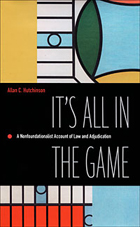 It's All in the Game: A Nonfoundationalist Account of Law and Adjudication
Allan C. Hutchinson
Duke University Press, 2000 Three questions concerning modern legal thought provide the framework for It’s All in the Game: What should judges do? What do judges do? What can judges do? Contrasting his own answers to traditional responses and moving playfully between debates of high theory, daily practices of appellate judges, and his own enlightening analyses of significant court rulings, Allan C. Hutchinson examines what it means to treat adjudication as an engaged game of rhetorical justification. His resulting argument enables the reader to grasp more fully the practical operation, political determinants, and the transformative possibilities of law and adjudication. Taking on leading contemporary theories to explore the claim that “law is politics,” Hutchinson delineates a route toward professional, relevant, and responsible—if radical—judicial practices. After discussing the difference between foundationalist, antifoundationalist, and nonfoundationalist legal critiques, he offers a focused, unequivocal, and positive account of the advantages of operating within a nonfoundationalist framework. Although such an approach centralizes the role of rhetoric in law, Hutchinson claims that this does not necessitate a turn away from politics or, more particularly, from a progressive politics. Driving home the political and jurisprudential impact of his critique and of his account of nonfoundationalist alternatives, he urges judges and jurists to engage in law’s language game of politics. This engaging book will interest linguistic philosophers, legal theorists, law students, attorneys, judges, and jurists of all stripes.
It's Been Beautiful: Soul! and Black Power Television
Gayle Wald
Duke University Press, 2015 Soul! was where Stevie Wonder and Earth, Wind & Fire got funky, where Toni Morrison read from her debut novel, where James Baldwin and Nikki Giovanni discussed gender and power, and where Amiri Baraka and Stokely Carmichael enjoyed a sympathetic forum for their radical politics. Broadcast on public television between 1968 and 1973, Soul!, helmed by pioneering producer and frequent host Ellis Haizlip, connected an array of black performers and public figures with a black viewing audience. In It's Been Beautiful, Gayle Wald tells the story of Soul!, casting this influential but overlooked program as a bold and innovative use of television to represent and critically explore black identity, culture, and feeling during a transitional period in the black freedom struggle.
ITS for Freight Logistics
Hironao Kawashima
The Institution of Engineering and Technology, 2022 The global economy requires globalized movement of goods. Freight transport operations need to be efficient, productive, safe and secure, clean and green. The use of ICT and ITS (intelligent transport systems) are addressing these challenges by developing more rapid, more reliable and more precisely timed strategies for freight transport.
It's Good to Be Black
Ruby Berkley Goodwin
Southern Illinois University Press, 1953 From the preface by Carmen Kenya Wadley:
“Is it good to be black? To Ruby Berkley Goodwin it was....The black she writes about has nothing to do with skin color, but it does have a great deal to do with self images, values, spiritual strength, and most of all love. Unlike the contradicting definitions of blackness we see reflected in today's crime statistics, movies, television, newspapers, political speeches, advertisements, and sociological reports, Ruby Berkley Goodwin's definition of blackness is simple and to the point: black is good. It's Good to be Black is more than the story (history) of a black family living in Du Quoin, Illinois, during the early 1900s; it is a reaffirmation for all of us who know in our hearts that there is still good in the world and that some of that good is black.”
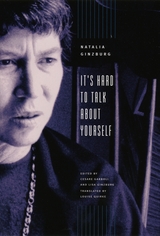 It's Hard to Talk about Yourself
Natalia Ginzburg
University of Chicago Press, 2003 Natalia Ginzburg, arguably the most important woman writer of postwar Italy, always spoke of herself with irrepressible modesty. Yet the woman who claimed she "never managed to climb up mountains" in fact wrote the history of twentieth-century Italy with her sparse and captivating prose, chronicling Fascism, war, and the Nazi occupation as well as the intimacies of family life.
Ginzburg's marriage to Leone Ginzburg, who met his death at the hands of the Nazis for his anti-Fascists activities, and her work for the Einaudi publishing house placed her squarely in the center of Italian political and cultural life. But whether writing about the Turin of her childhood, the Abruzzi countryside, where her family was interned during World War II, or contemporary Rome, Ginzburg never shied away from the traumas of history-even if she approached them only indirectly, through the mundane details and catastrophes of personal life.
Intensely reserved, Ginzburg said that she "crept toward autobiography stealthily like a wolf." But she did openly discuss her life and her work in an extraordinary series of interviews for Italian radio in 1990. Never before published in English, It's Hard to Talk about Yourself presents a vivid portrait of Ginzburg in her own words on the forces that shaped her remarkable life-politics, publishing, literature, and family. This fluid translation will join Ginzburg's autobiography, Family Sayings, as one of the most important records of her life and, as the editors write in their preface, "the last, unexpected, original book by Natalia Ginzburg."
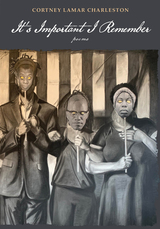 It's Important I Remember: Poems
Cortney Lamar Charleston
Northwestern University Press, 2026 An incantation of strength and solace for persisting in twenty-first-century America
“History doesn’t repeat, it rhymes.” In his sweeping third collection, Charleston brings a poet’s ear for echo and rhythm to bear on American history and life after 2016. For Charleston, these rhymes cut two ways: the long tradition of American racism and fascism, and the steady pulse of Black persistence. The collection’s titular invocation frames each poem, at times an oratory to rally a crowd, in other moments a private prayer whispered as the speaker gathers himself to face another day. Charleston insists that should we cede memory of our national biography—whether to repression or indifference—we will witness the country’s dissolution into something unrecognizable to most, yet all too familiar to its most marginalized people. But with each reiteration and riff, he also invokes a tenuous hope—that if we summon an American history of Black resistance, we might still make a more perfect union.
It's in There!®
William Morton Hildebolt and Bonnie Bajorek Daneker
Ohio State University Press, 2017
Prego Spaghetti Sauce has been a flagship product in Campbell Soup Company’s portfolio for more than thirty years. This book showcases the creativity, science, and determination that were key to Prego’s development. From the tomato breeding to the recipe formulation to the engineering and mechanical feats necessary for production—not to mention the marketing research and advertising efforts needed to position Prego in the marketplace—It's In There!® is a memoir-based product history of an iconic brand found today in kitchens around the world.
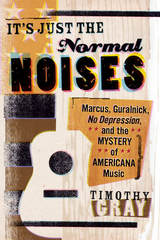 It's Just the Normal Noises: Marcus, Guralnick, No Depression, and the Mystery of Americana Music
Timothy Gray
University of Iowa Press, 2017 Roots rock, Americana, alt country: what are they and why do they matter? Americans have been trying to answer these questions for as long as the music bearing these labels has existed. Music can function as an escape from the outside world or as an explanation of that world. Listeners who identify with the music’s message may shape their social understandings accordingly. Rock critics like Greil Marcus and Peter Guralnick, the titans of rock criticism, tap this fluid dichotomy, considering the personal appeal of roots music alongside national ideals of democracy and selfhood. So too do many other critics, novelists, and fans, explaining to themselves and us how music forms our selves and the communities we seek out and build up.
In It’s Just the Normal Noises, Timothy Gray examines a wide array of writing about roots music from the 1960s to the 2000s. In addition to chapters on the genre-defining work of Guralnick and Marcus, he explores the influential writings of Grant Alden and Peter Blackstock, the editors of No Depression magazine, and the writers who contributed to its pages, Bill Friskicks-Warren, Ed Ward, David Cantwell, and Allison Stewart among them. A host of memoirists and novelists, from Patti Smith and Ann Powers to Eleanor Henderson and Dana Spiotta, shed light on the social effects and personal attachments of the music’s many manifestations, from punk to alt country to hardcore. The ambivalent attitudes of rock musicians toward success and failure, the meaning of soul, the formation of alternative communities through magazine readership, and the obsession of Generation X scenes with DIY production values wend through these works.
Taking a personal approach to the subject matter, Gray reads criticism and listens to music as though rock ‘n’ roll not only explains American culture, but also shores up his life. This book is for everyone who’s heard in roots rock the sound of an individual and a nation singing themselves into being.
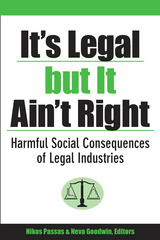 It's Legal but It Ain't Right: Harmful Social Consequences of Legal Industries
Nikos Passas and Neva Goodwin
University of Michigan Press, 2005 "It's Legal but It Ain't Right chronicles the abuse of power and privilege by businesses that defy the strictures of law and limits of regulation. Contributors stretch the conceptual boundaries of corporate deviance across a wide range of industries at a time when standards of corporate social responsibility and good corporate citizenship are in flux."
--William S. Laufer, Professor, The Wharton School of Business
"This delightful and serious book involves a matter I have long felt of first importance. That is our tendency to make social truth and acceptance conform to personal or larger corporate interests. On this I have written , but gladly yield to this persuasive parallel. No one concerned with literate, informed, and relevant---as distinct from self-serving---truth should miss It's Legal but It Ain't Right."
--John Kenneth Galbraith
"This absorbing and well-written book of essays on the harmful consequences of legal industries skillfully illuminates the ways in which some corporate harms fail to be transformed into criminal law-making and enforcement, and offers cogent suggestions for better regulation in the public interest."
--Dr. Michael Levi, Professor of Criminology, Cardiff University
Many U.S. corporations and the goods they produce negatively impact our society without breaking any laws. We are all too familiar with the tobacco industry's effect on public health and health care costs for smokers and nonsmokers, as well as the role of profit in the pharmaceutical industry's research priorities. It's Legal but It Ain't Right tackles these issues, plus the ethical ambiguities of legalized gambling, the firearms trade, the fast food industry, the pesticide industry, private security companies, and more. Aiming to identify industries and goods that undermine our societal values and to hold them accountable for their actions, this collection makes a valuable contribution to the ongoing discussion of ethics in our time.
This accessible exploration of corporate legitimacy and crime will be important reading for advocates, journalists, students, and anyone interested in the dichotomy between law and legitimacy.
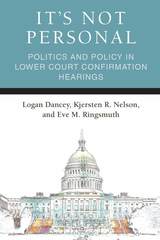 It's Not Personal: Politics and Policy in Lower Court Confirmation Hearings
Logan Dancey, Kjersten R. Nelson, and Eve M. Ringsmuth
University of Michigan Press, 2020 In order to be confirmed to a lifetime appointment on the federal bench, all district and circuit court nominees must appear before the Senate Judiciary Committee for a confirmation hearing. Despite their relatively low profile, these lower court judges make up 99 percent of permanent federal judgeships and decide cases that relate to a wide variety of policy areas. To uncover why senators hold confirmation hearings for lower federal court nominees and the value of these proceedings more generally, the authors analyzed transcripts for all district and circuit court confirmation hearings between 1993 and 2012, the largest systematic analysis of lower court confirmation hearings to date. The book finds that the time-consuming practice of confirmation hearings for district and circuit court nominees provides an important venue for senators to advocate on behalf of their policy preferences and bolster their chances of being re-elected. The wide variation in lower court nominees’ experiences before the Judiciary Committee exists because senators pursue these goals in different ways, depending on the level of controversy surrounding a nominee. Ultimately, the findings inform a (re)assessment of the role hearings play in ensuring quality judges, providing advice and consent, and advancing the democratic values of transparency and accountability.
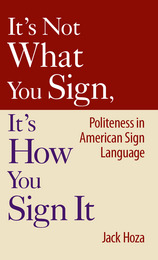 It’s Not What You Sign, It’s How You Sign It: Politeness in American Sign Language
Jack Hoza
Gallaudet University Press, 2007 The general stereotype regarding interaction between American Sign Language and English is a model of oversimplification: ASL signers are direct and English speakers are indirect. Jack Hoza’s study It’s Not What You Sign, It’s How You Sign It: Politeness in American Sign Language upends this common impression through an in-depth comparison of the communication styles between these two language communities. Hoza investigates relevant social variables in specific contexts and explores the particular linguistic strategies ASL signers and English speakers employ when they interact in these contexts.
It’s Not What You Sign, It’s How You Sign It is framed within politeness theory, an apt model to determine various interpretations of what speakers or signers mean in respect to the form of that which they say or sign. The variations reveal how linguistic and cultural differences intersect in ways that are often misinterpreted or overlooked in cross-cultural communication. To clarify these cross-linguistic differences, this volume explores two primary types of politeness and the linguistic strategies used by English speakers and ASL signers to express politeness concerns in face-to-face interaction. Hoza’s final analysis leads to a better understanding of the rich complexity of the linguistic choices of these language groups.
 It's Not Your Fault!: Strategies for Solving Toilet Training and Bedwetting Problems
Joseph Barone, M.D.
Rutgers University Press, 2015 Millions of children over the age of five wet their beds every night. Many parents think they must be doing something wrong when their five-year-old is still in diapers while their friends’ children are perfectly trained by eighteen months of age. This undoubtedly is a very embarrassing and frustrating problem for both the parent and child, and can interfere with family dynamics and a child’s ability to enjoy ordinary social situations.
It’s Not Your Fault! offers evidence-based strategies for parents who need assistance with toilet training and helping their child with urinary control issues. Dr. Joseph Barone, M.D., provides proven techniques that bring bedwetting to a happy conclusion. Frequently, parents are misguided by bad advice from friends, TV talk shows, the Internet, or parenting books. With many years of clinical experience, Dr. Barone shares valuable, practical information for parents to guide them through the basics of toilet training and bedwetting, and presents management plans to resolve any difficulties that occur. A comprehensive guide, this book covers everything parents need to know about normal toilet training and bedwetting, as well as step-by-step solutions based on testing and research in a real-world setting to help children suffering from delayed toilet training, bed wetting, and daytime urinary wetting.
It’s Not Your Fault! provides hope and guidance to those desperate to help their children overcome urinary control and toilet training problems. Dr. Barone sets parents on a course that makes things better for both themselves and their children.
It's Official!: The Real Stories behind Arkansas’s State Symbols
David Ware
Butler Center for Arkansas Studies, 2015 Since Arkansas’s creation as an independent territory in 1819, its legislature has officially designated a wide assortment of symbols. Some of these refer to economic mainstays while others attest to the aspirations of those who saw a bright future for their extensive and varied community. This volume’s essays examine each of Arkansas’s officially designated symbols, outlining their genesis, their significance at the time of their adoption, and their place in modern Arkansas. Combining political narratives, natural history, and the occasional “shaggy dog” story, Ware makes a case for considering the symbols as useful keys to understanding both the Arkansas that has been and the one it hopes to be.
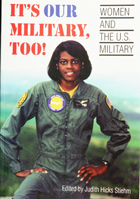 It's Our Military Too: Women and the U.S Military
edited by Judith Hicks Stiehm
Temple University Press, 1996 In the last twenty-five years the U.S. military has seen the abolition of women's separate corps, the appointment of women generals, and an unprecedented increase in the ratio of women to men. Also, women are now permitted to serve on combat planes and ships. Despite these developments, most civilians know very little about women in the military. This collection includes unusual accounts by women on active duty, retired officers, women who have worked for the armed forces in a civilian capacity, and civilian academics. The book offers insights on a variety of pressing issues including minority women, lesbians, combat, the role of gender in weapons design, and the changing mission of the military. Through personal accounts and commentaries, this book dispels many of the myths about women and the military and explores the reasons for the persistence of misconceptions in the face of increased female participation. This comprehensive effort will be of interest to anyone who wants to know the truth about women in the armed forces and will be a wake-up call to women who feel that the military is irrelevant to them.
Contributors: Rhonda Cornum, Virginia Solms, Billie Mitchell, Connie L. Reeves, Brenda L. Moore, Nina Richman-Loo, Rachel Weber, Lucinda Joy Peach, M. C. Devilbiss, Carol Burke, Susan Jeffords, Miriam Cooke.
 It's So French!: Hollywood, Paris, and the Making of Cosmopolitan Film Culture
Vanessa R. Schwartz
University of Chicago Press, 2007 The recent history of cultural exchange between France and the United States would appear to be defined by “freedom fries” and boycotts against Beaujolais—or, on the other side of the Atlantic, by enraged farmers toppling statues of Ronald McDonald. But this dismal state of affairs is a long way from the mutual admiration that followed World War II, epitomized in a 1958 cover of Look magazine that declared “Brigitte Bardot conquers America.” It’s So French! explores the close affinity between the French and American film industries that flourished in the postwar years, breaking down myths of American imperialism and French cultural protectionism while illuminating the vital role that cinema has played in the globalization of culture.
Hollywood was once enamored with everything French and this infatuation blossomed in a wildly popular series of films including An American in Paris, Gigi,and Funny Face. Schwartz here examines the visual appeal of such films, and then broadens her analysis to explore their production and distribution, probing the profitable influences that Hollywood and Paris exerted on each other. This exchange moved beyond individual films with the sensational spectacle of the Cannes Film Festival and the meteoric career of Brigitte Bardot. And in turn, their success led to a new kind of film that celebrated internationalism and cultural hybridity. Ultimately, Schwartz uncovers an intriguing paradox: that the road to globalization was paved with nationalist clichés, and thus, films beloved for being so French were in fact the first signs of a nascent cosmopolitan culture.
Packed with an array of colorful film stills, publicity photographs, paparazzi shots, ads, and never before seen archival images, It’s So French! is an incisive account of the fertile collaboration between France and the United States that expanded the geographic horizons of both filmmaking and filmgoing, forever changing what the world saw and dreamed of when they went to the movies.
ITS vol 16 num 1
The University of Chicago Press
University of Chicago Press Journals, 2013
ITS vol 17 num 1
The University of Chicago Press
University of Chicago Press Journals, 2014
ITS vol 17 num 2
The University of Chicago Press
University of Chicago Press Journals, 2014
ITS vol 18 num 1
The University of Chicago Press
University of Chicago Press Journals, 2015
ITS vol 18 num 2
The University of Chicago Press
University of Chicago Press Journals, 2015
ITS vol 19 num 1
The University of Chicago Press
University of Chicago Press Journals, 2016
ITS vol 19 num 2
The University of Chicago Press
University of Chicago Press Journals, 2016
ITS vol 20 num 1
The University of Chicago Press
University of Chicago Press Journals, 2017
ITS vol 20 num 2
The University of Chicago Press
University of Chicago Press Journals, 2017
ITS vol 21 num 1
The University of Chicago Press
University of Chicago Press Journals, 2018
ITS vol 21 num 2
The University of Chicago Press
University of Chicago Press Journals, 2018
ITS vol 22 num 1
The University of Chicago Press
University of Chicago Press Journals, 2019
ITS vol 22 num 2
The University of Chicago Press
University of Chicago Press Journals, 2019
ITS vol 23 num 1
The University of Chicago Press
University of Chicago Press Journals, 2020
ITS vol 23 num 2
The University of Chicago Press
University of Chicago Press Journals, 2020
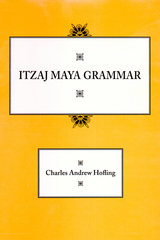 Itzaj Maya Grammar
Charles A Hofling
University of Utah Press, 2000 The Itzaj Maya language is a member of the Yukatekan Maya language family spoken in the lowlands of Guatemala, Mexico, and Belize, a family that includes Maya, Mopan, and Lakantum. Many classic Maya hieroglyphic texts were written in an earlier form of these languages, as were many important colonial documents. In addition to being a valuable record of ancient language, Andrew Hofling’s Itzaj Maya Grammar contributes greatly to the study of these older documents. This exemplary grammar completes a basic documentation that began with Itzaj Maya Texts and Itzaj Maya-Spanish-English Dictionary. It’s coverage of the linguistic structures of Itzaj includes the phonological, morphophonological, and syntactic structures. Each morphological and grammatical construction is carefully explained, with additional examples of each construction included. Itzaj Maya Grammar is a landmark contribution to the study of discourse in Maya language. When used with Hofling’s previous texts, it provides a thoroughly dynamic documentation of the language, useful to all interested in the study of Yukatejan languages or linguistics.
Itzaj Maya Spanish English Dictionary
Charles A Hofling
University of Utah Press, 1997 Of immense value to linguists, anthropologists, epigraphers, and ethnobotanists
•More than twenty-thousand entries
•In trilingual format with extensive Spanish-Itzaj Maya and English Itzaj indexes
•Includes a grammatical sketch describing morphological and syntactic processes of Itzaj Maya words
•Three appendixes present flora and fauna taxonomy and an overview of body parts
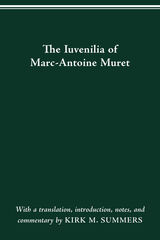 The Iuvenilia of Marc-Antoine Muret
With a translation, introduction, notes, and commentary by Kirk M. Summers
Ohio State University Press, 2006 Marc-Antoine Muret (1526–1585) was a major figure in humanist classical scholarship. A superb Latinist, he influenced, among others, the Dutch humanist Justus Lipsius. This is the first English translation, with introduction, notes, and commentary, of Muret’s Latin iuvenilia. The juvenilia cover a wide variety of literary genres: odes, satires, epigrams, elegies, and epistles. Modeled on the classical poets Horace, Catullus, and Martial, these poems also reveal an acquaintance with the works of Muret’s contempories Joachim Du Bellay and Jean Dorat.
A growing interest in the contributions and perspectives of Renaissance authors who wrote in Latin has created an urgent need for accessible modern editions of their works. There is no hope of truly understanding the Renaissance, which, after all, was a revival of ancient learning integrated with an emerging modern world view, without taking into account the large body of work produced by neo-Latin authors. The Iuvenilia of Marc-Antoine Muret helps fill the need for critical editions that provide a general context and interpretation. A major neo-Latin poet, Muret was thoroughly versed in classical literature, mythology, rhetoric, and philosophy. He had inherited centuries of medieval learning and practices, both secular and religious. Muret incorporated the generic innovations of contemporary humanists while referring to current events and figures. In short, he summed up in his own person the body of human endeavor and thinking as it stood in his own time.
Given Muret’s importance, this lively translation by Kirk M. Summers, with an introduction, notes, and commentary, will appeal to classicists, including those interested in the classical tradition, as well as to scholars working on the French and European Renaissance.
 Ivan Aksakov, 1823-1886: A Study in Russian Thought and Politics
Stephen Lukashevich
Harvard University Press Here is a complete biography of Ivan Aksakov, a prominent intellectual figure in Russia during the reigns of Tzars Alexander II and III. Aksakov began his fiery career as a critic of Slavophilism, a movement created by his brother Konstantin, along with Alexis Khomiakov, the brothers Kireevskii, and others, which sought to divorce Russia from the West and all Western influence. Circumstances, however, turned Aksakov into the fanatical leader of the Slavophiles, making him a passionate nationalist and Pan-Slavist, and a fierce anti-Semite. Although he accepted the reforms of the 1860's, he feared that their results would lead to the further Westernization of Russia; and, toward the end of his life, disillusioned and despairing, he lent a generous hand to reaction.
This book is based on a meticulous study of primary sources such as collected works, correspondence, private memoirs, and recollections.
|
|

